Croatia’s second city is unlike anywhere else you might consider for a family city break – centred around the ancient remains of Roman emperor Diocletian’s palace, you’ll also find plenty of other things to do in Split with kids.
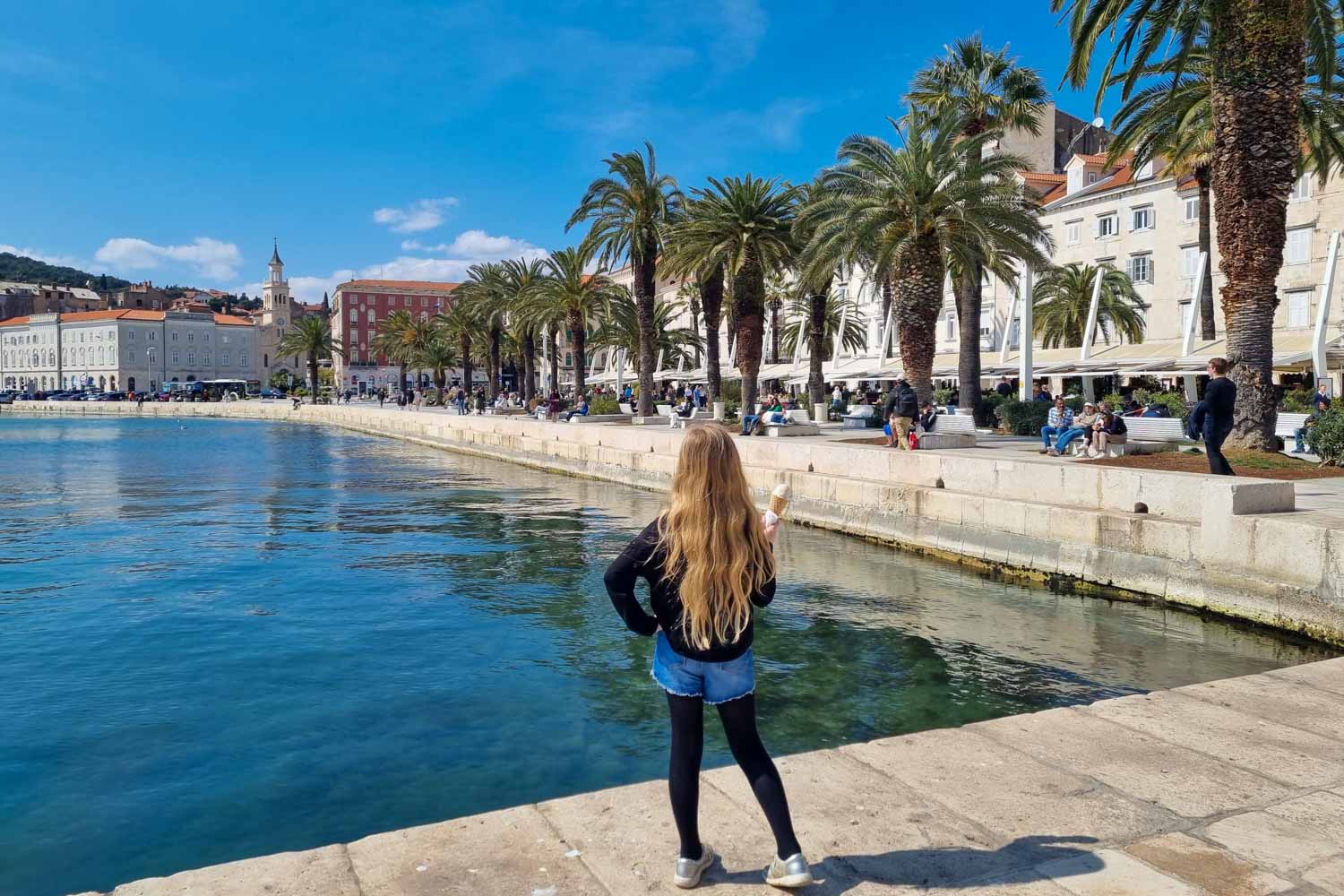
contains affiliate links*
Just wandering the narrow winding streets, retracing the route that Roman citizens and soldiers would have walked centuries before, makes exploring an unforgettable experience.
But you’ll also find a few quirky family attractions plus beaches and green space near Split with kids as well, while the city is also a great base for day trips out to the nearby islands and Krka National Park too.
Explore Diocletian’s Palace
The whole of Split’s historic heart was once part of Diocletian’s palace – the Unesco World Heritage site is not a single place to visit but the buildings, squares and alleys are now converted into restaurants, shops, little squares and more.
So just strolling the streets is one of the big attractions of a city break in Split with kids. But there are a few sites you shouldn’t miss, to discover some of the original Roman buildings inside the walls as well.
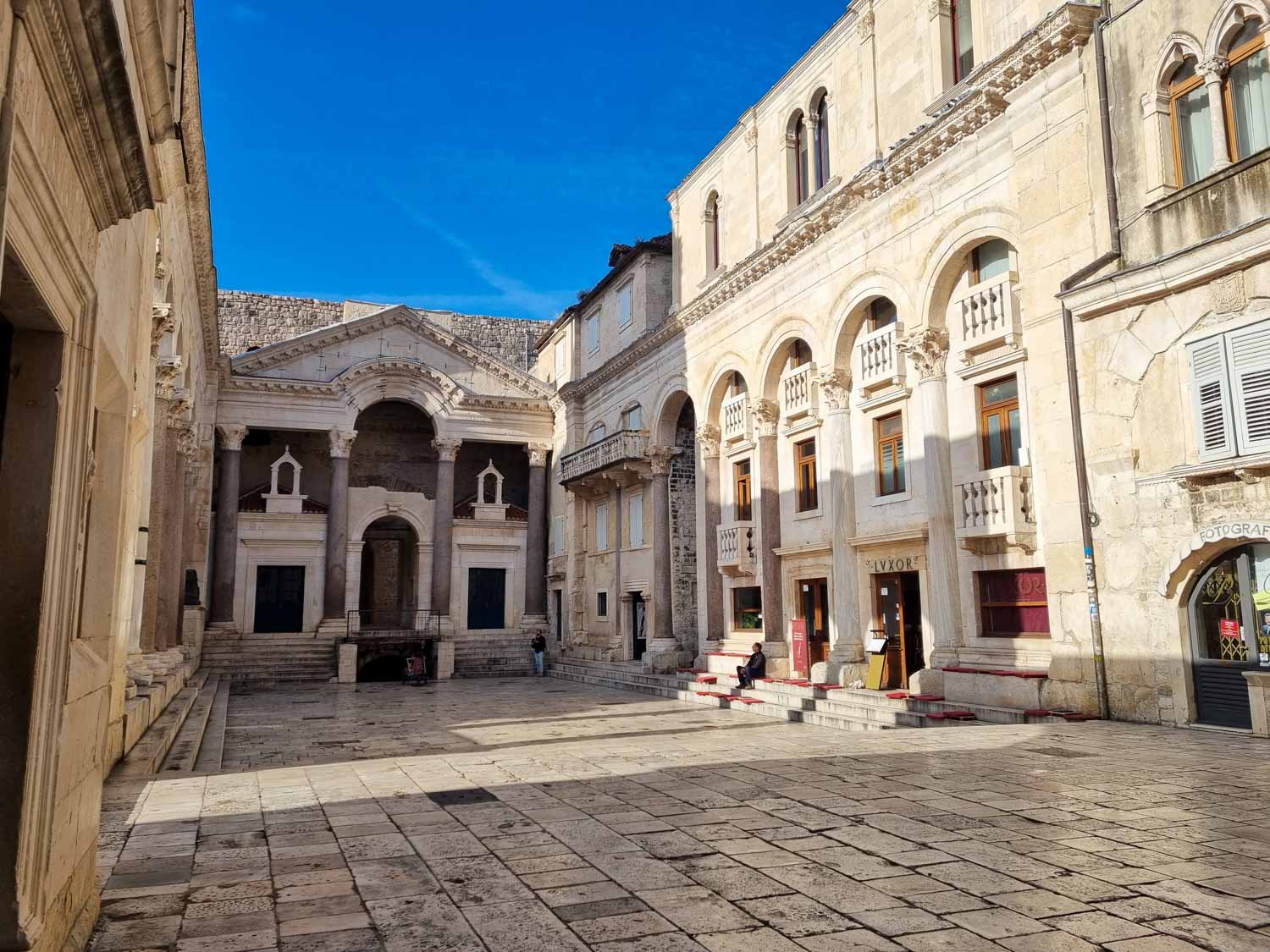
Head in through the southern Brass Gate (or Bronze gate) from the waterfront Riva and you’ll find a series of underground rooms to explore – some echoing chambers, plus lots of excavated artefacts to see, from columns to huge beams.
It’s split into two sections, with a map on arrival, although you can wander at will if you don’t want to follow the suggested route. Along the way, there are signs with background about the palace, as well as other details to spot such as individual mason’s marks, plus a bust of Diocletian himself, the man who put Split on the map.
It’s one of a string of Croatian filming locations from Game of Thrones too, as a bonus for parents or if you’re visiting Split with teens – Daenarys Targaryen kept her dragons chained down here, although we spotted nothing more ferocious than a black cat as we explored.
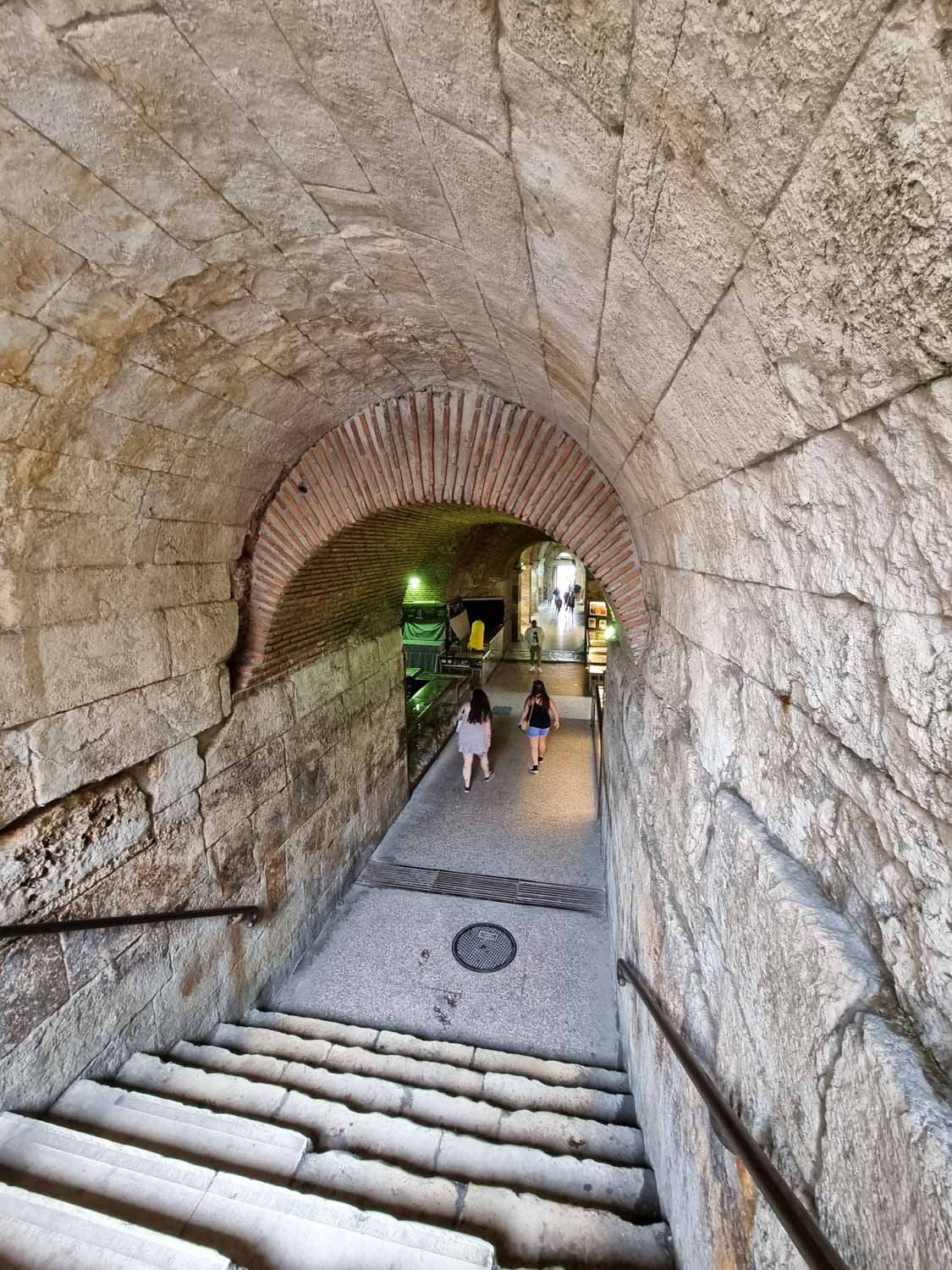
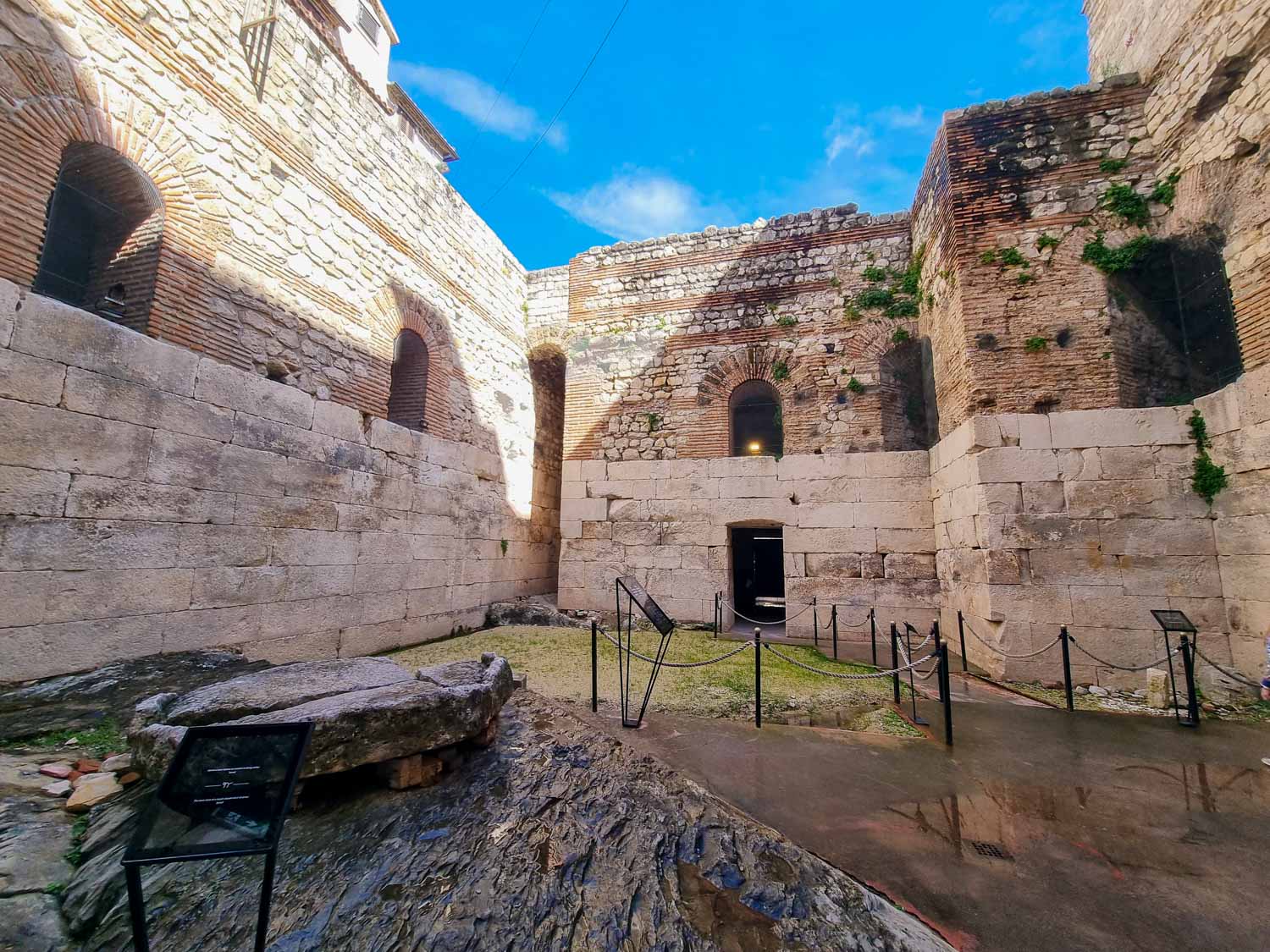
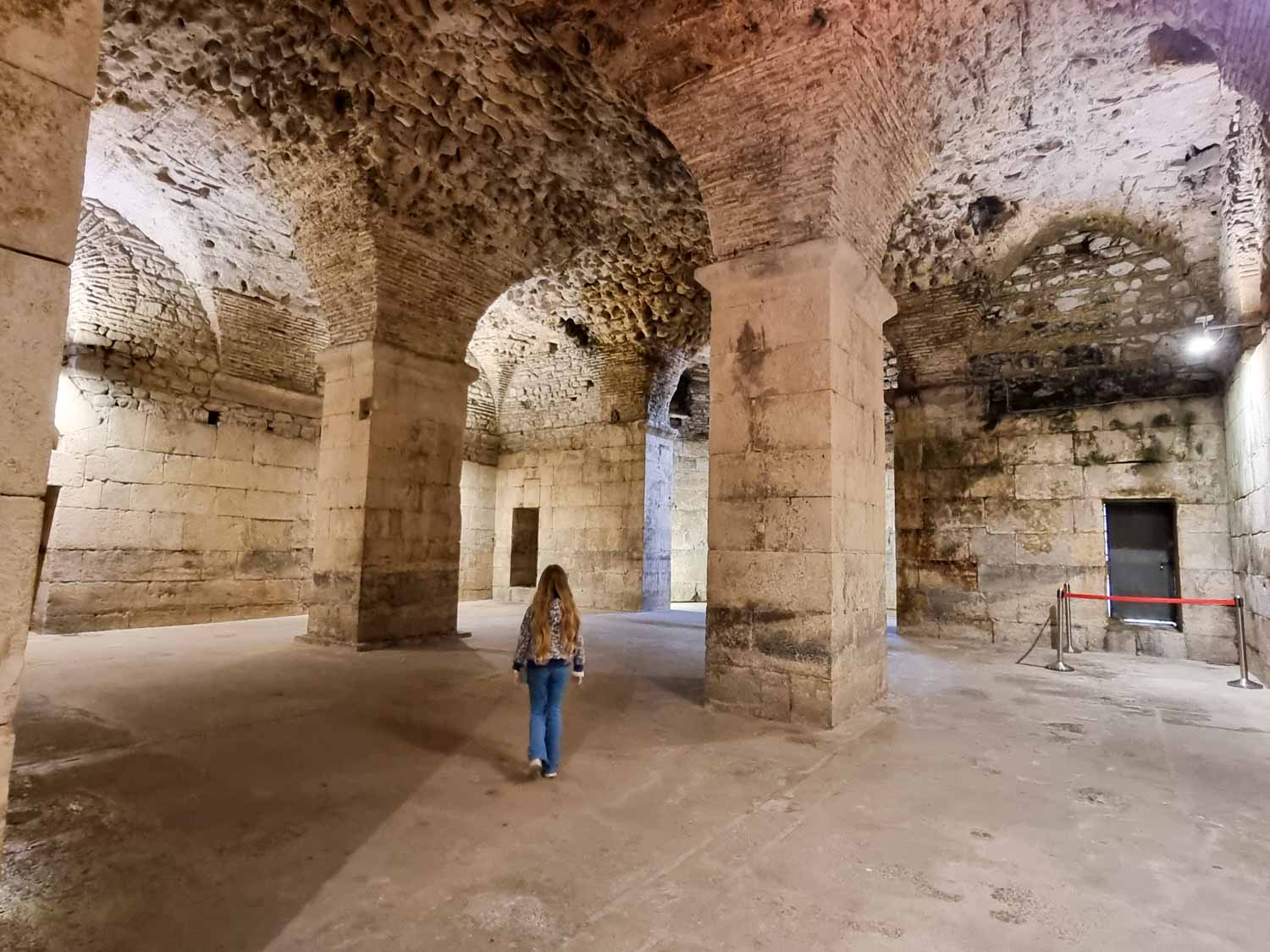
If your kids have a low tolerance for historic sites, it doesn’t take long to explore so it’s easy to get a quick taste while you’re in Split with kids, without having to dedicate a day to ancient Roman remains.
Visiting outside peak season, we bought tickets on arrival (kids under 6 enter free, and there’s a reduced rate for children otherwise) but you can also book via Get Your Guide with free cancellation.
Diocletian’s Dream VR experience
To bring the ancient Roman city back to life, a visit to the Diocletian’s Dream VR experience is fantastic with kids.
A virtual stone’s throw from the city’s Golden Gate and Grgur Ninski statue, the experience recreates Split as it was when Diocletian ruled the Roman Empire, leading you from the present-day crypts through the streets of the city, inside the palace’s private rooms and even over to the waterfront.
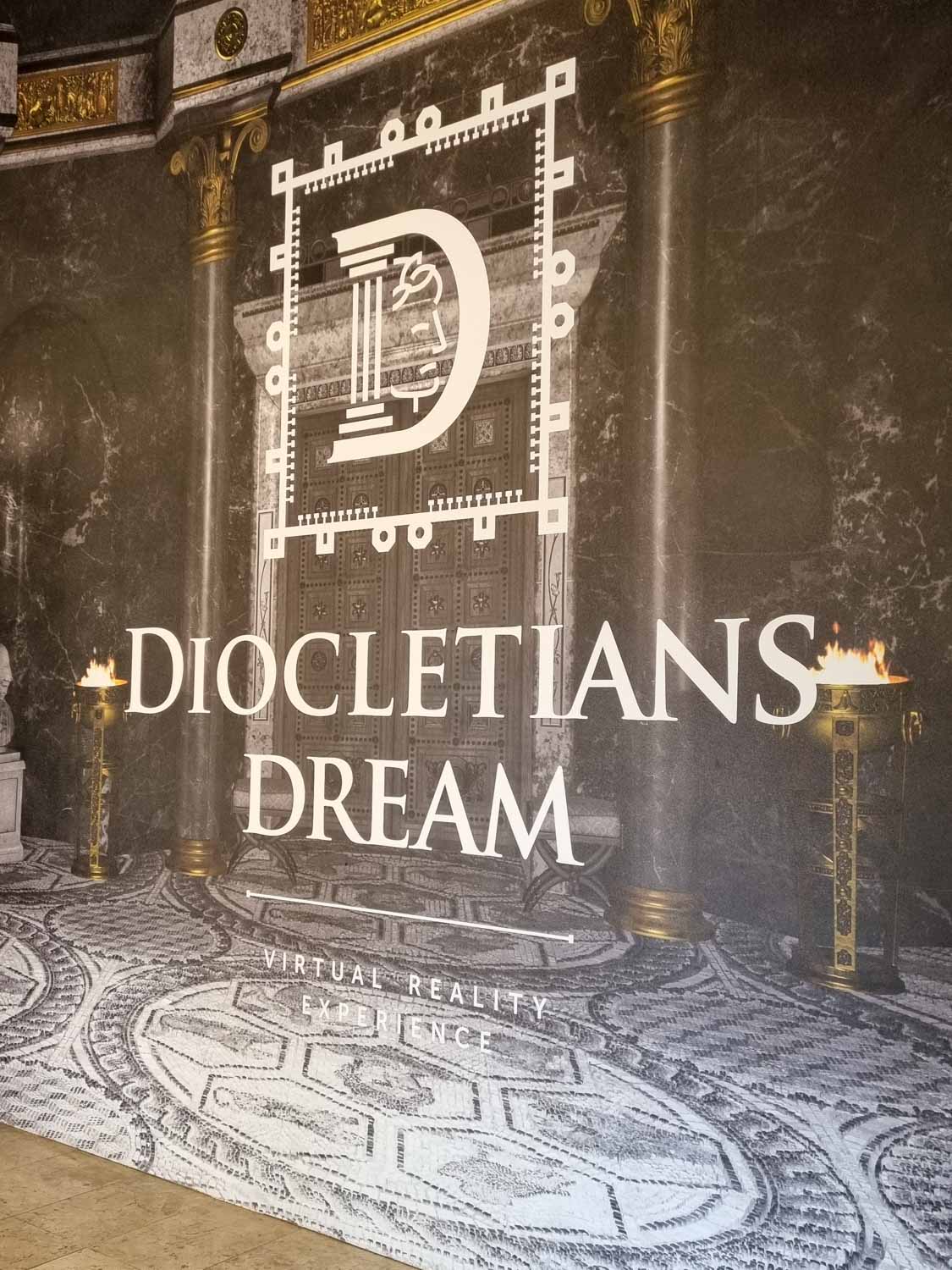
It’s often incredibly realistic – I felt like I could reach out and touch some objects and ducked at least once – and while the experience isn’t a long one, it’s the perfect introduction to the city.
Ideal for helping kids (and adults!) visualise Split as it would have been back in 305AD when the palace was being completed. Recommended for around age 7-8+.
As an added bonus, any Monty Python fans can keep an eagle eye out for the very brief Life of Brian reference!
You can also buy tickets to Diocletian’s Dream with free cancellation here
Wander the palace streets
Even if you don’t fancy going inside any of the ancient buildings – or if you only have one day in Split with kids – save some of it to wander around Split’s historic heart.
There are four gates into the city, each named for a different metal. The grandest of them is the gold gate in the north, although most visitors to the city tend to use the brass (or bronze) gate in the south, leading from the Riva into Diocletian’s palace.
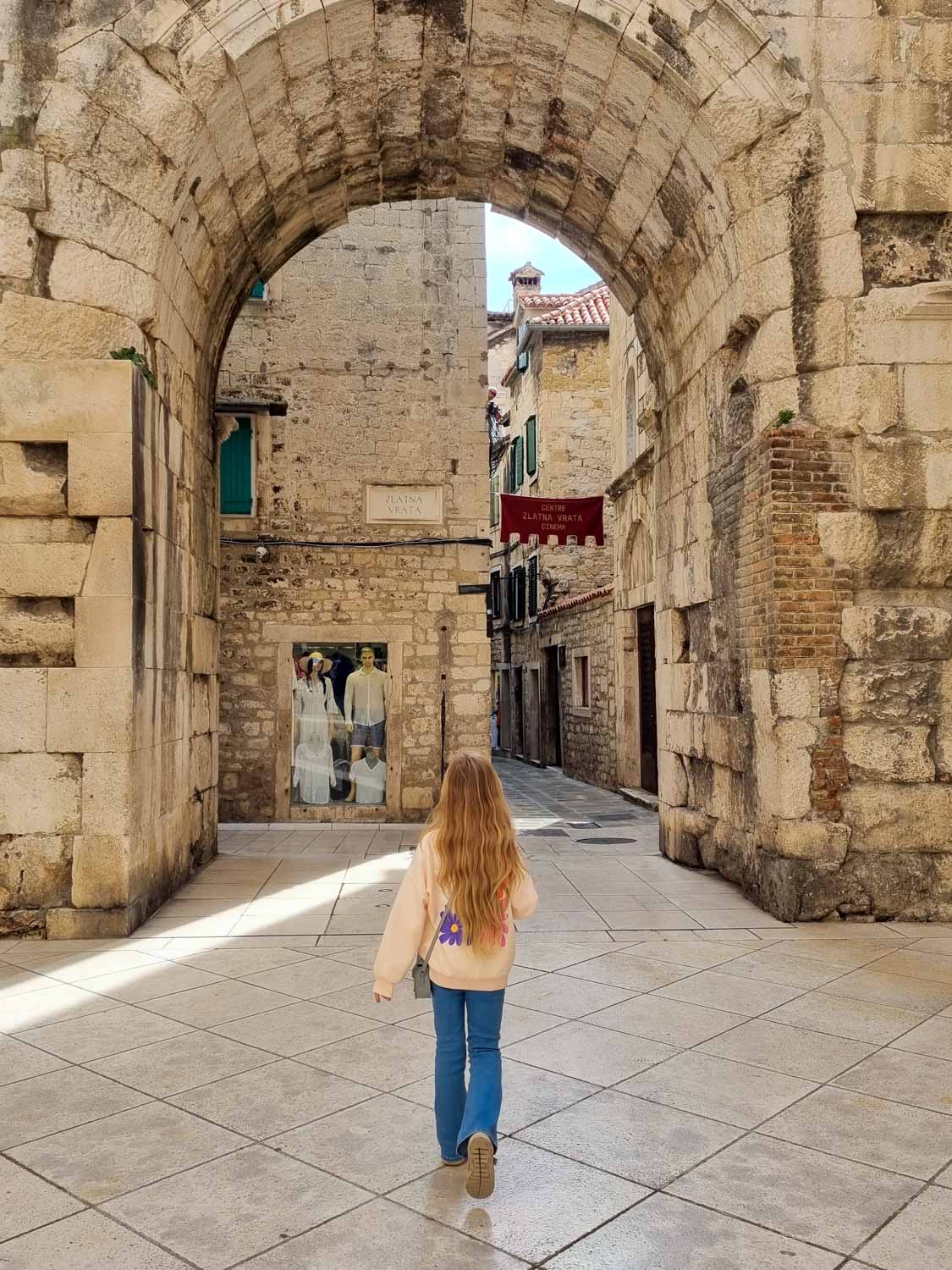
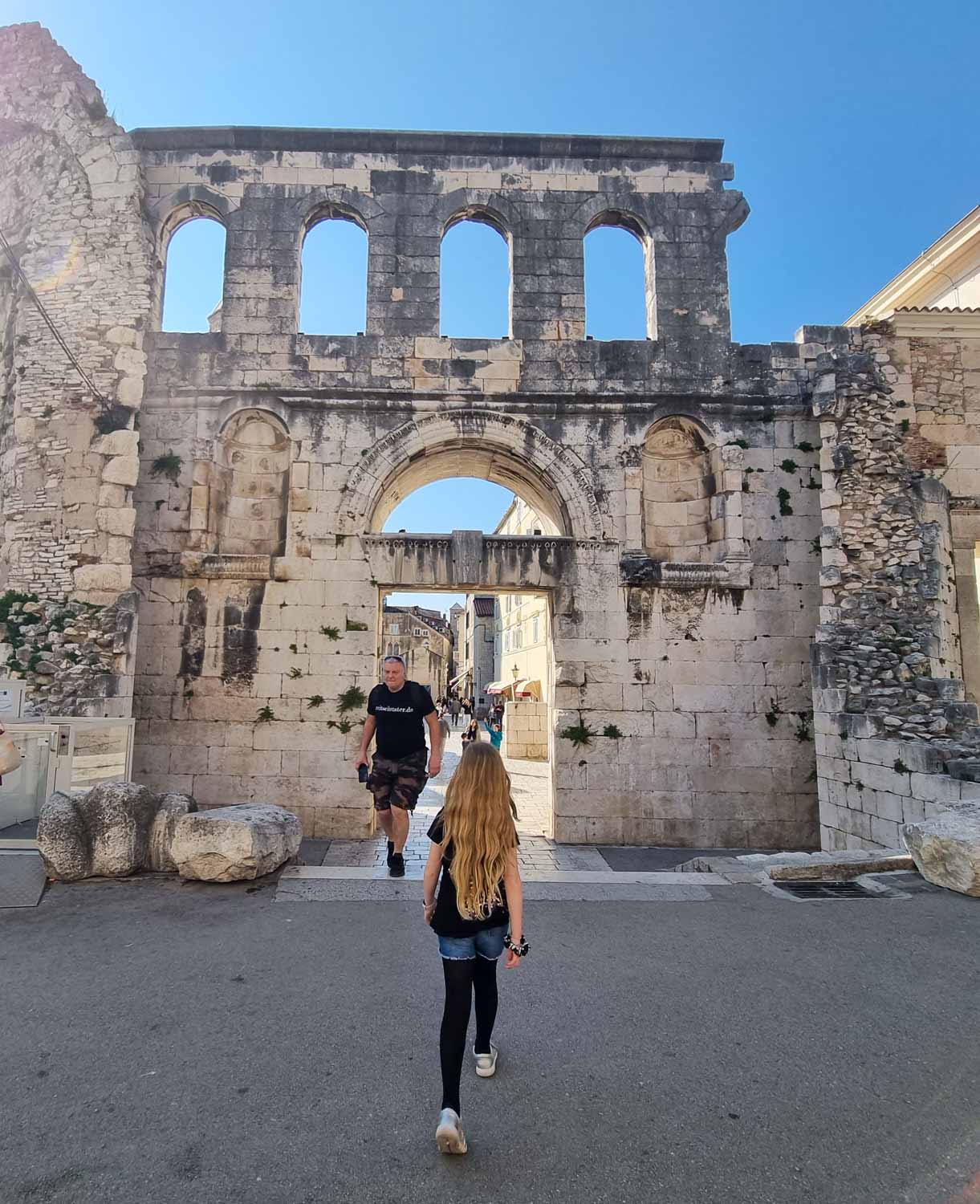
Once it would have led directly onto the water, when the emperor (or other goods and people) arrived by water.
In the east, there’s the silver gate, and the iron gate lies to the west. The Decumanus connects the two, one of two main thoroughfares crossing the city, and dividing the palace into the emperor’s residence and the rooms used for practical and official purposes.
Stroll from west to east on the centuries-old paving slabs and it brings you out towards the green market. Along the way, you’ll pass through the Peristil (or Peristyle) – the small square at the heart of the old city, with the cathedral of St Domnius on and the entrance to the vaults.
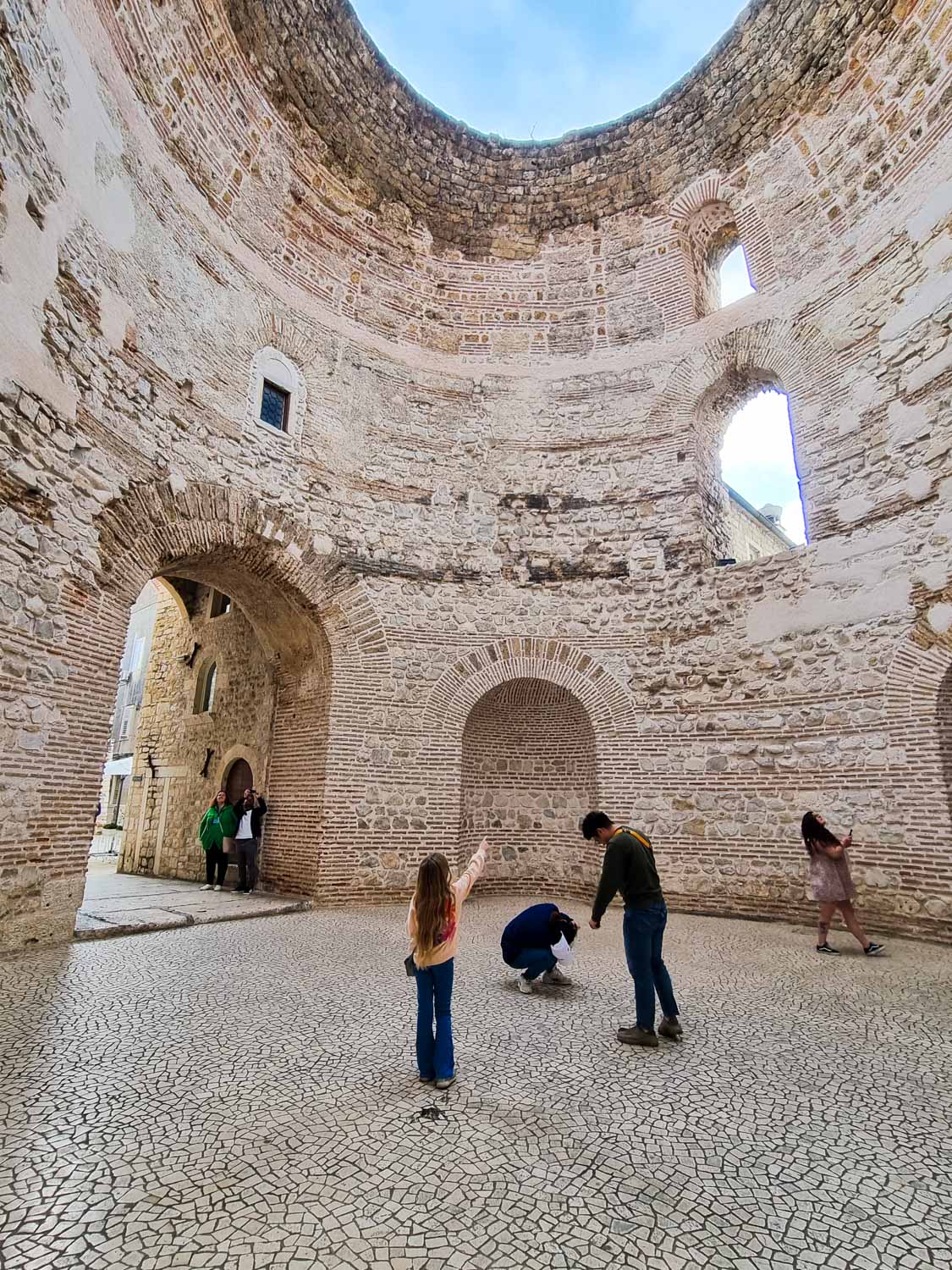
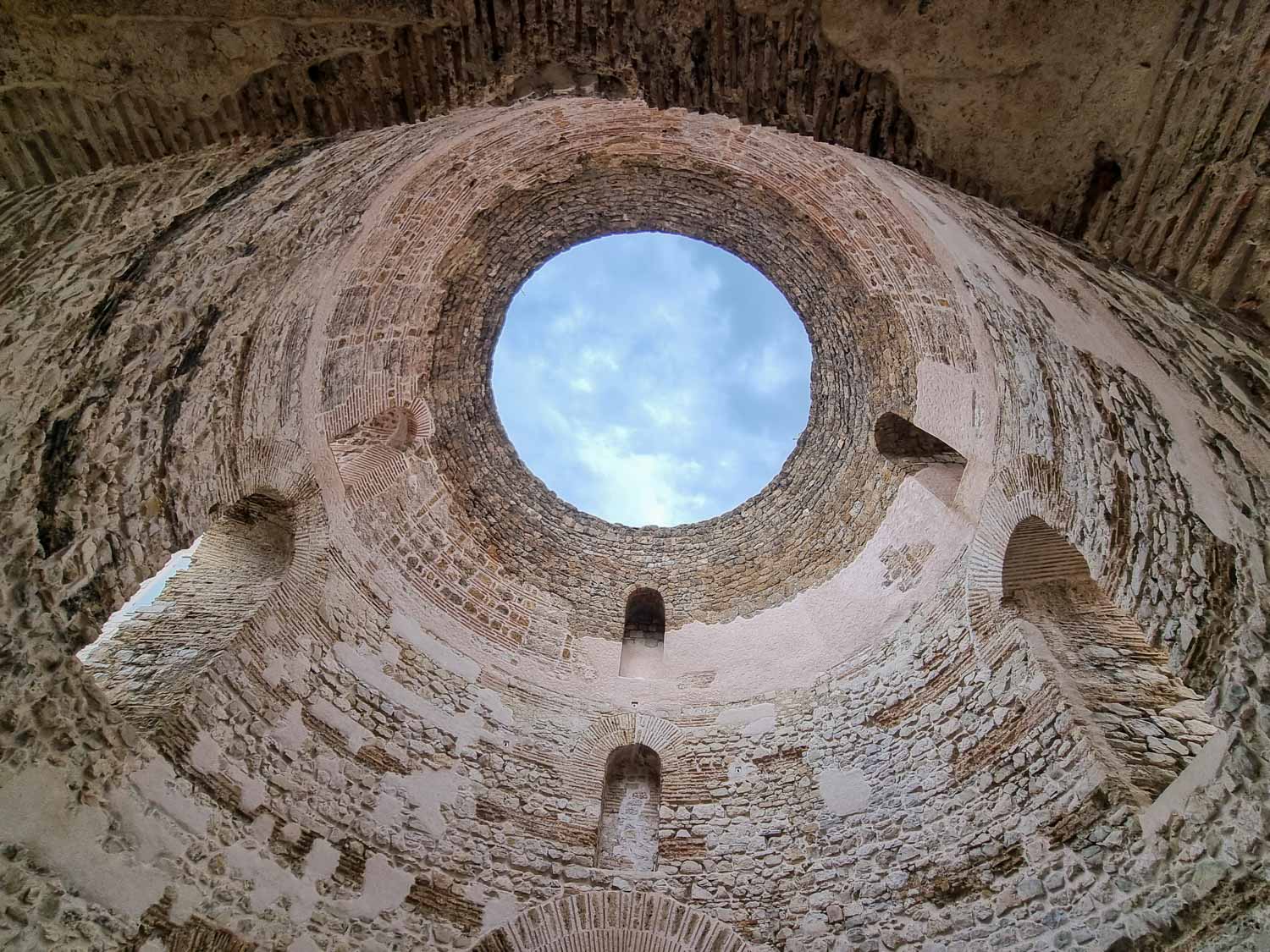
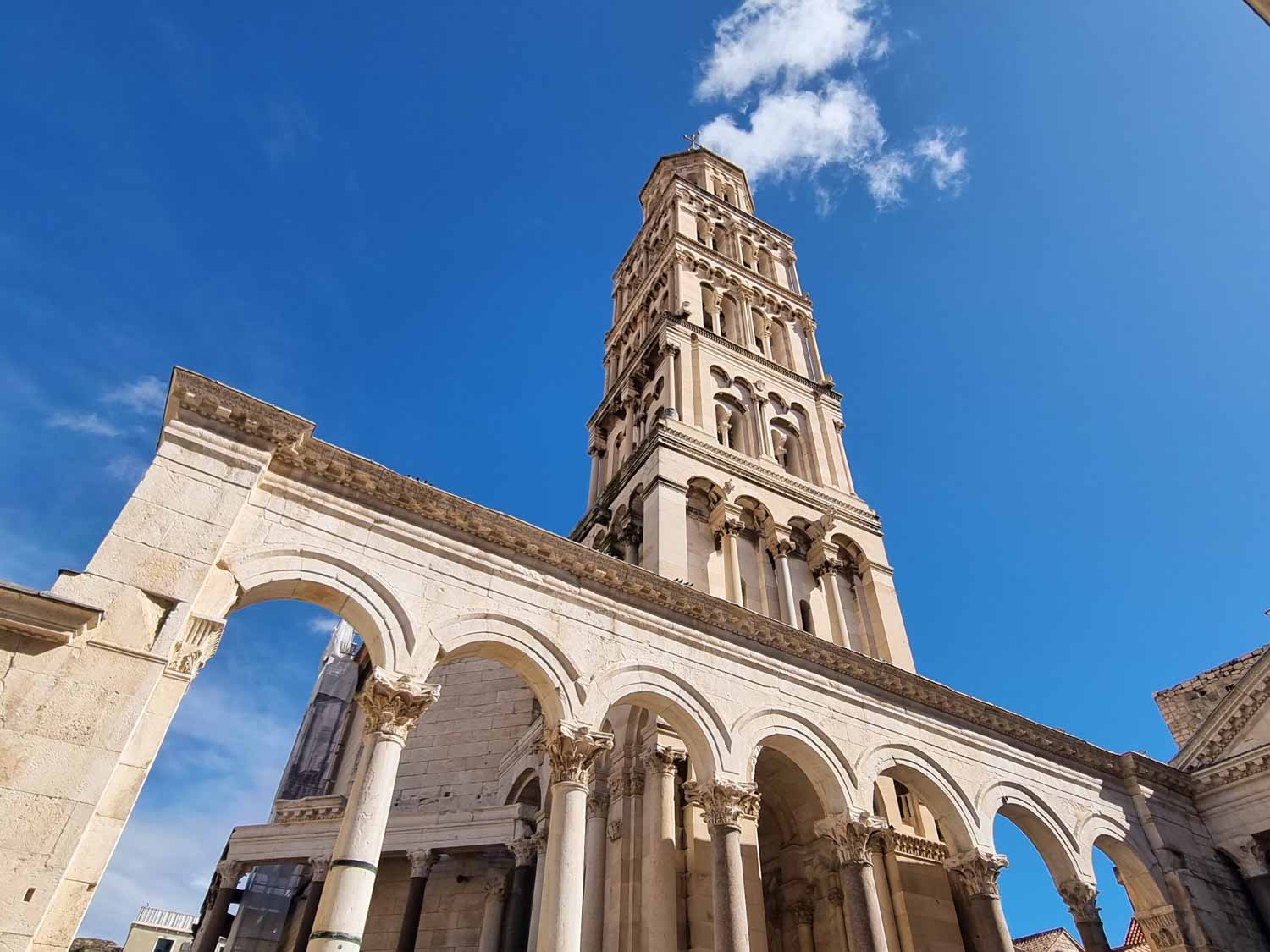
If you head back towards the waterfront from here, make sure you also venture up to the higher level where you can see more remains of rooms from the imperial palace, including the triclinum (the emperor’s dining room) near the Ethnographic Museum and the dramatic vestibule, a round room with an open space in the dome high above.
Visit St Domnius cathedral (Diocletian’s mausoleum)
Wherever you wander in Split, the belltower of the cathedral of St Domnius towers over the old buildings (and makes a handy reference point to navigate if you get lost in the maze of streets).
Once Diocletian’s mausoleum, the fall of the Roman Empire just over a century after his death saw it turned into a Christian place of worship dedicated to a Christian saint martyred during his reign.
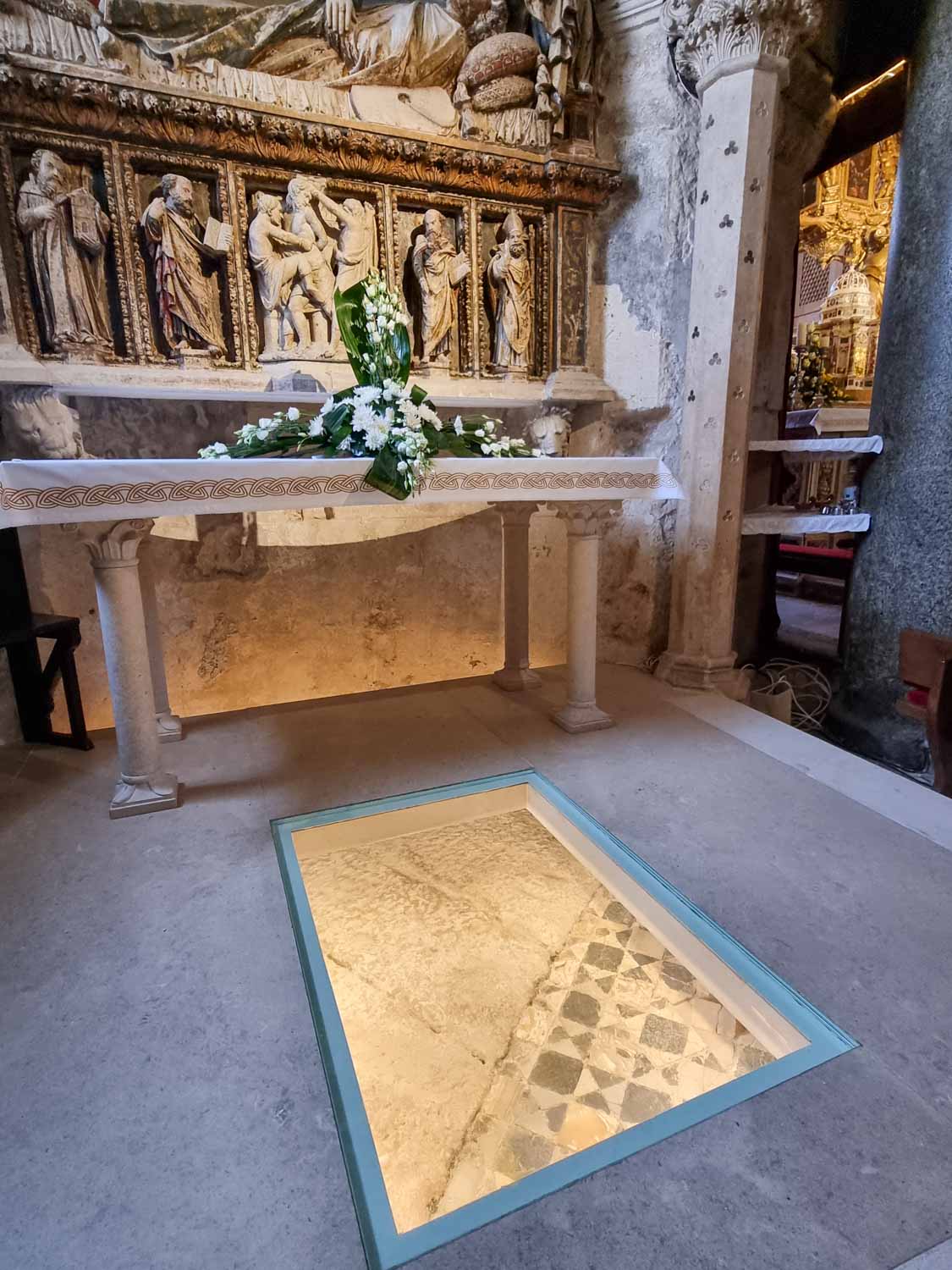

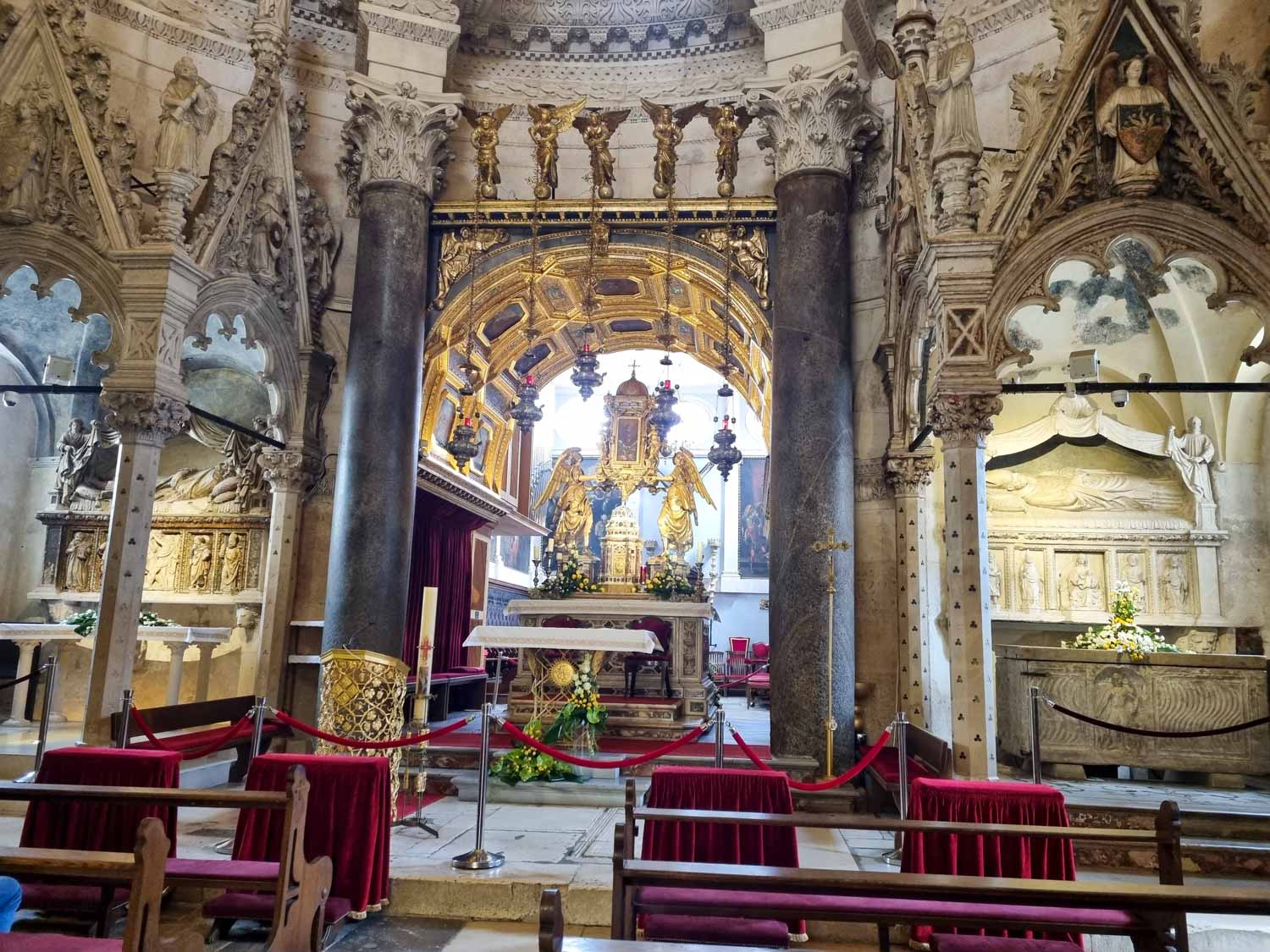
The emperor’s sarcophagus was also destroyed, but the octagonal structure itself is one of the best-preserved Roman buildings still standing. The 24 columns around the outside are also original.
Inside, you can still see some of the original mosaic flooring through covered openings in the current cathedral floor, as well as the intricately carved wooden door.
Tickets must be bought before you enter the cathedral in the ticket office on the opposite side of the Peristil – you can buy individual tickets or combined ones, including the belltower, the treasury, crypt and baptistery, although the crypt and treasury may not be open outside peak season.
The cheapest combined option, the blue ticket, includes the cathedral, crypt and baptistery, while the purple ticket includes all the sites.
Climb the cathedral belltower
The cathedral’s belltower was built much later than the mausoleum itself, with the oldest parts dating from the 13th century (reconstructed after it collapsed in 1908).
Rising 57m above the city, there are around 200 steps to get to the top – firstly stone steps, then metal ones, so you need a good head for heights (and decent thigh muscles!) to get up there.

The views across the rooftops and out to sea are fantastic though. As the stairs are narrow and twisty (plus they can get crowded in summer), it’s not ideal with younger kids or anyone who doesn’t like heights.
Tickets must be bought before you enter the cathedral complex in the ticket office opposite – you can buy individual tickets or combined ones, including the cathedral, the treasury, crypt and baptistery, although the crypt and treasury may not be open outside peak season.
Marvel at the cathedral treasury
Some of the city’s greatest treasures are now housed in a medieval palace on the Peristil Square – moved a few years ago from the treasury’s former home in the building next to the cathedral.
While younger kids probably won’t be as excited by the sight of historic illuminated manuscripts, there are some wonderful reliquaries made from precious metals and paintings to see.
The whole collection is divided over three floors, including Roman artefacts as well as later artworks.
Individual and combined tickets are available from the ticket office on the Peristil, which is also the entrance to the treasury – you can buy options including the cathedral, belltower, crypt and baptistery, although the crypt and treasury may not be open outside peak season.
See the baptistery
The former temple of Jupiter is the last of the key sights on the Peristil, as the open square by the cathedral of St Domnius is known.
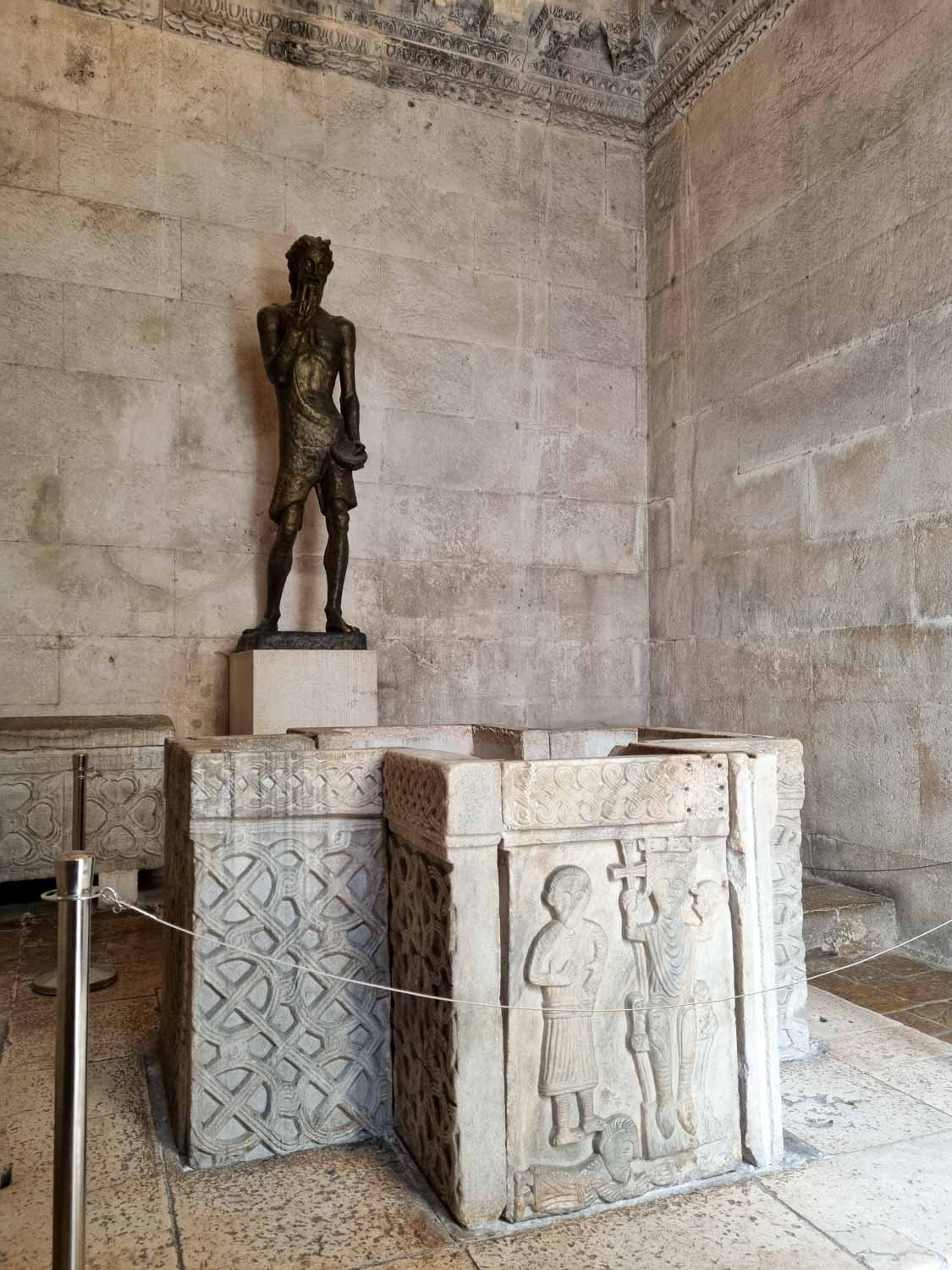

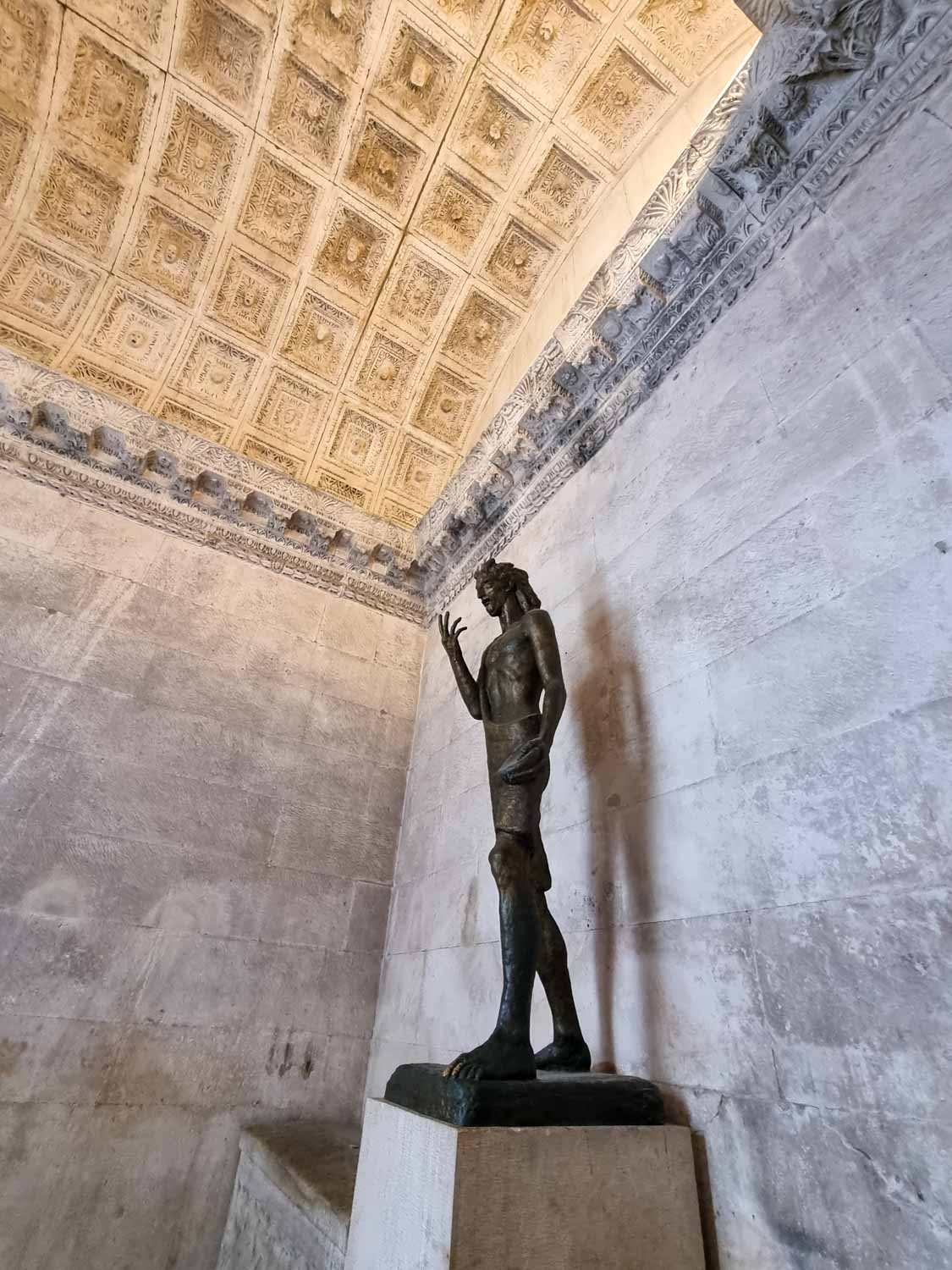
Sitting opposite the cathedral itself, it was built at the end of the 3rd century as a small temple to the king of the gods before suffering a similar fate to Diocletian’s mausoleum and being converted by the Christians, probably in the 6th century.
It’s not huge but you can spot two stone sarcophagi belonging to the city’s archbishops as well as one of the earliest carvings of a Croatian king (either Peter Kresimir or Demetrius Zvonimir).
Outside the front is a black granite sphinx, brought by Diocletian from Egypt to Split in the 3rd century – but it’s since lost its head, after the early Christians defaced it, considering it to be a pagan symbol.

The sphinx near the cathedral on the other side of the Peristil, thought to be over 3,000 years old, has survived rather better.
Tickets must be bought before you enter from the ticket office in the Peristil – you can buy individual tickets or combined ones, including the cathedral, belltower, the treasury and crypt, although the crypt and treasury may not be open outside peak season.
Spot the model of Split
If you don’t fancy a virtual view of Split – or simply can’t get enough ways to look at this fantastic city, head down to the Riva, Split’s waterfront promenade.
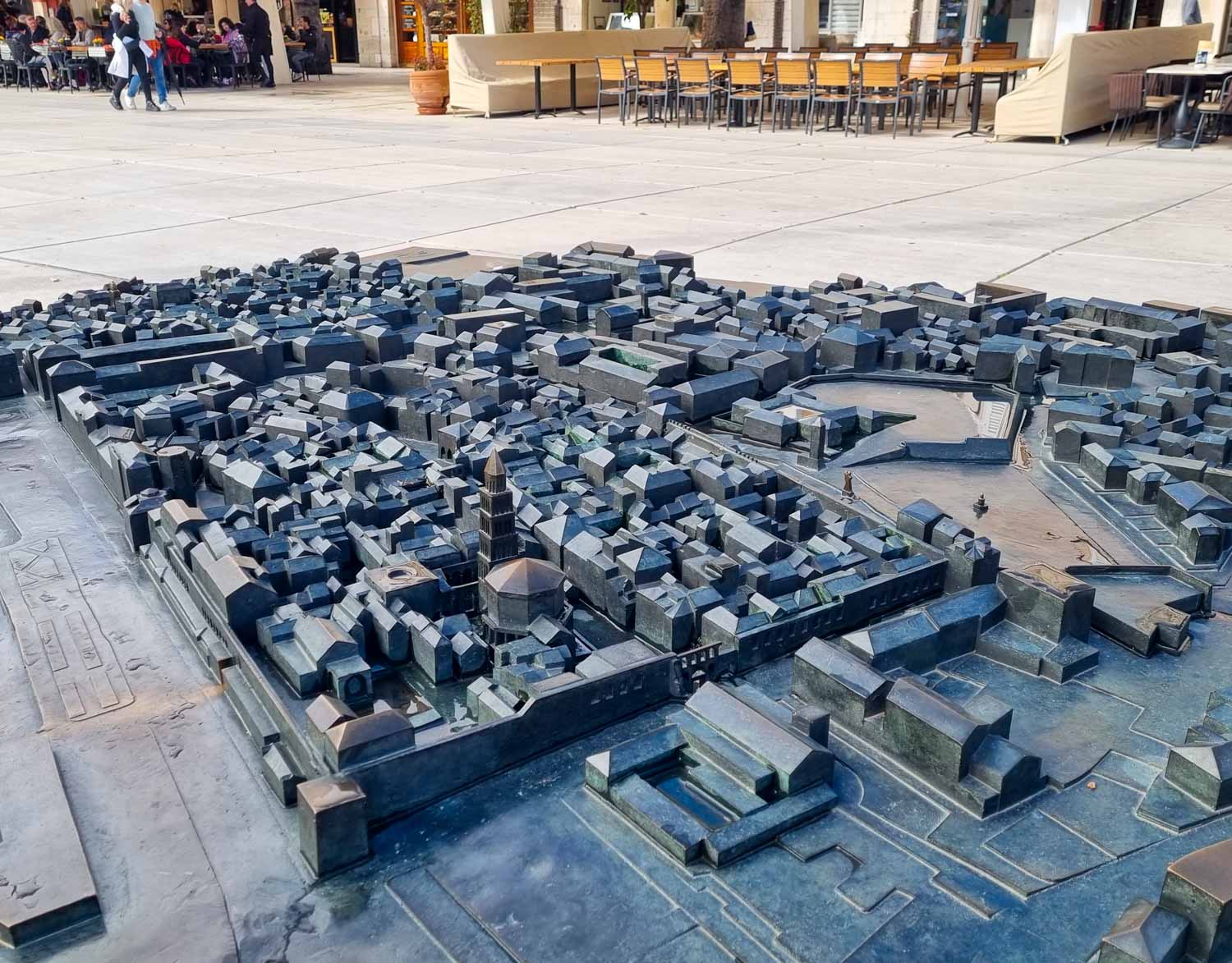
At the end near the Green Market, you can find the model down towards the benches under the palm trees. A few spots are rubbed gold, where it has been touched for good luck, and you can try to spot a few of the city’s landmarks.
Touch Grgur Ninski’s toe
The statue of the medieval bishop stands at the top of the steps just outside the Gold Gate into Diocletian’s Palace.
And if you wouldn’t normally go out of your way to find a 10th century bishop, this 28 foot statue has an added reason to stop by.


Not just the fact it’s 28 feet tall and pretty imposing, or the fact the Grgur Ninski stands right next to a little park and play area (although that’s always a bonus) – but because it’s said that if you rub the statue’s toe, you’ll get good luck (or come back to Split, although that’s good luck in itself).
Whether it’s true or not, the statue’s toe is gleamingly shiny, so you definitely won’t be the only ones seeing if that comes true.
Wander along the Riva
Save some time for a stroll along the Riva, as Split’s riverfront promenade is known. The main section is lined with restaurants, shops and cafes, running between the Green Market towards Trg Republike (home to one of our favourite restaurants during our trip, Restaurant Bajamonti).
It’s here that you can spot the bronze model of Split, as well as relaxing on one of the benches under a palm tree as you watch boats sail past. There are plenty of places selling ice cream if you want to grab a cone as you wander.
Once the Diocletian Palace dock, heading east brings you to the modern-day port where both the ferries and smaller cruise ships dock, while if you walk the opposite way, it will lead you eventually towards Marjan Park and the smaller Sustipan Park near the marina.
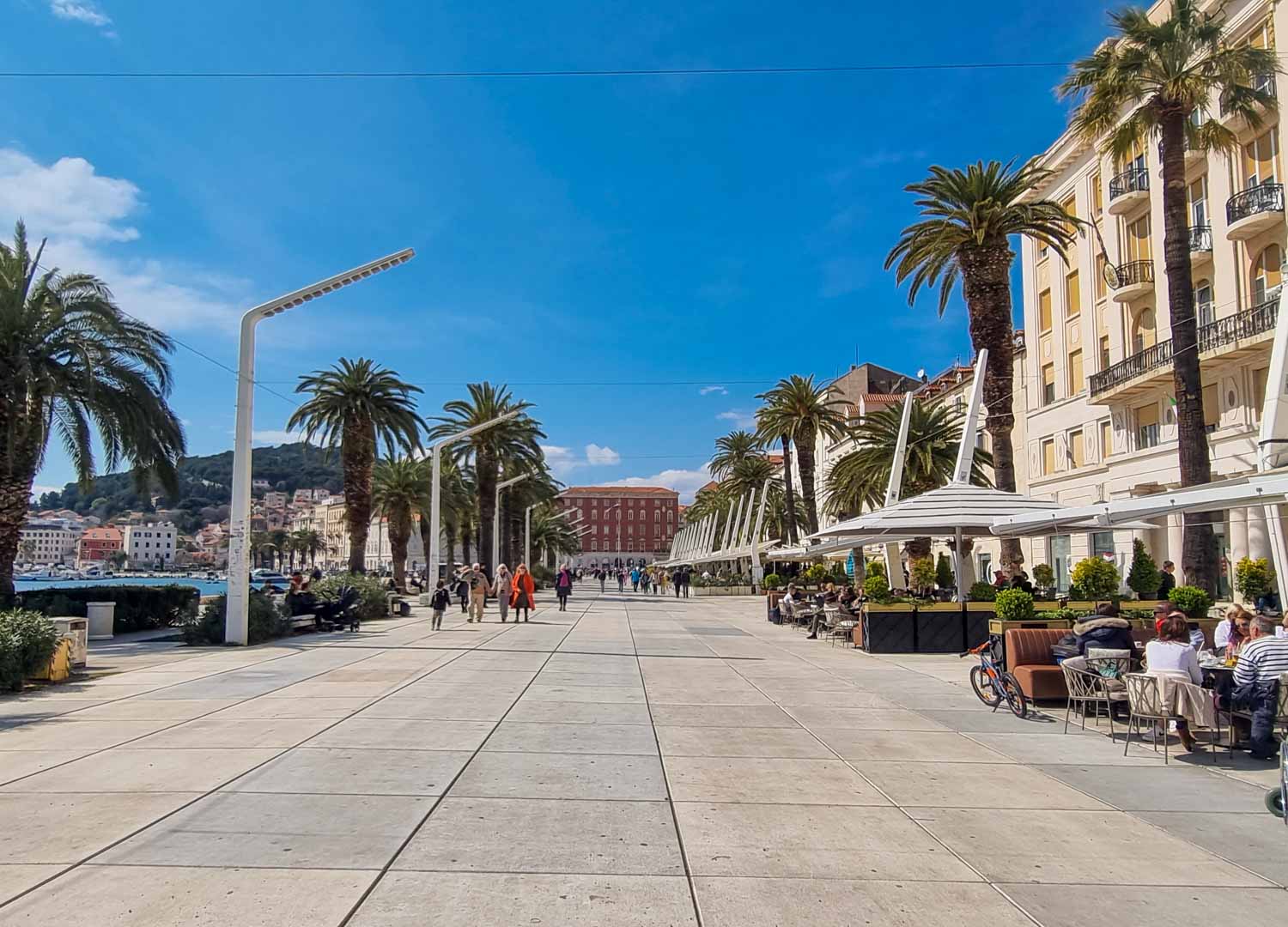
Stroll through the green market
You don’t have to be shopping to enjoy a visit to the open-air green market in Split – although if you’re self-catering, the temptation to pick up some of the fabulous fruit and vegetables, bread and cheese is high.
Other flea-market style stalls have anything from antiques to bric-a-brac and souvenirs, as well as flowers.
Soak up some of the colourful atmosphere, although if you do want to buy, stick to traders who have prices visible on their stalls.
Explore Marjan Park
Walking distance from the old town, Marjan Forest Park is a huge hilly protected green space that stretches for a couple of miles, with a series of hills and viewpoints looking back onto Split.
The lowest viewpoint is only around a 15-minute walk from the centre of town, next to a 16th century Jewish graveyard, an easy climb if you just want a taste of the park without wandering too far. We headed along the Riva and then the steps are only a few streets away, although there are several ways in.
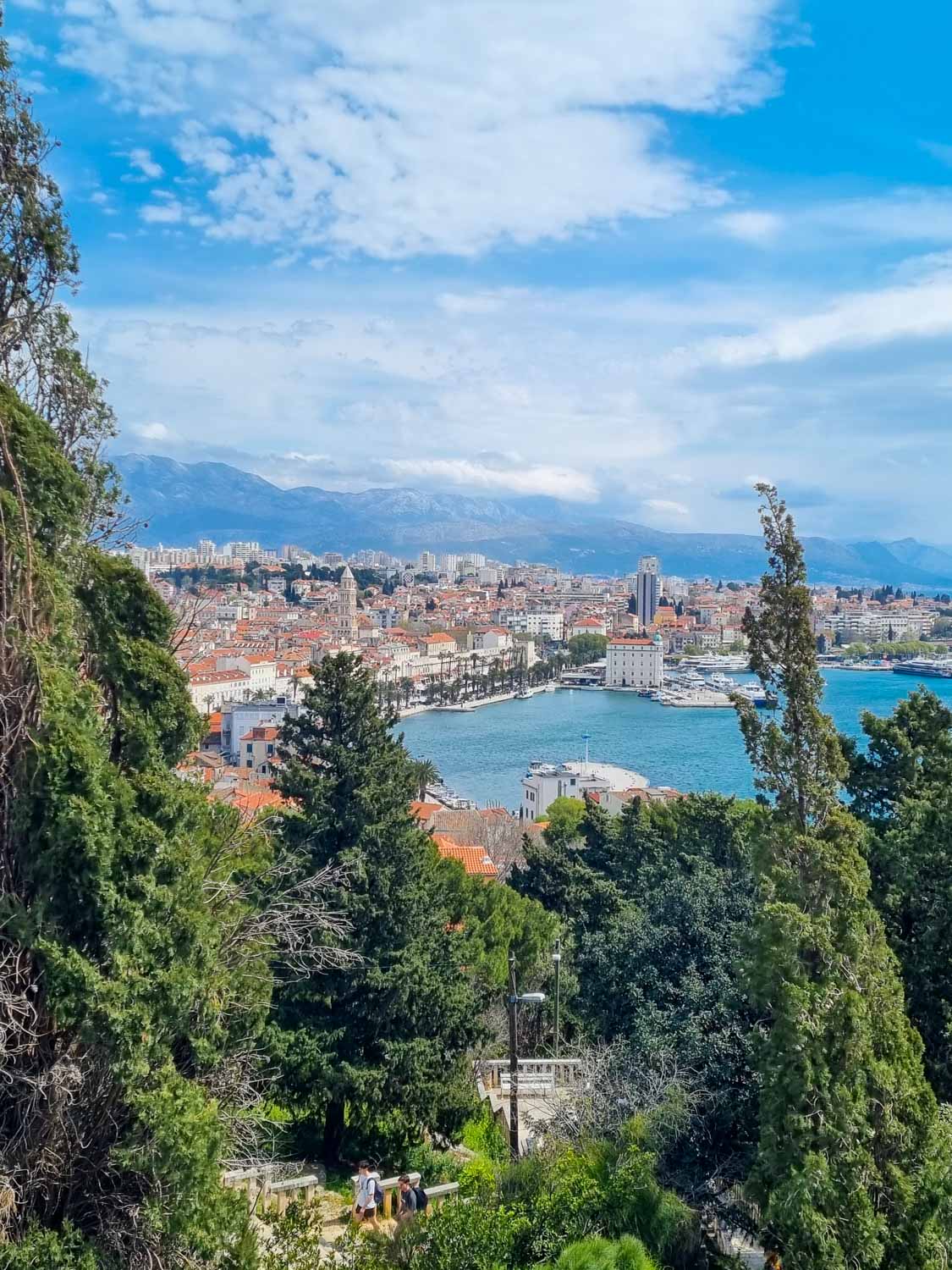


Once we were inside, we decided to walk on to the next viewpoint… and the next one, until we ended up on Marjan’s highest spot at 178m up, under the Croatian flag fluttering and snapping in the breeze. The views are spectacular, with the whole of Split laid out beneath you, including the ships docked in the port beyond the red tiled roofs.
You could spend all day wandering and discovering the nature reserve’s hidden corners though: there are biking and hiking trails, a stone ‘labyrinth’ (more like a pattern of stones), old buildings, an art gallery, play areas, a little beach.
You can even hire kayaks to venture out onto the sea as well, if you’re looking for more activities to try.
The park is also home to Split Zoo and Natural History Museum – read on for more about the zoo, but the museum, which was only ever a small collection, seems to have closed completely.
If you prefer to explore Marjan Park with a guide, this three-hour family-friendly hiking tour takes you to some of the key spots

Split Zoo
Based in Marjan Forest Park, Split Zoo has had a chequered history to say the least – I’d read dreadful reviews about the conditions the animals were kept in, until eventually it closed in around 2015.
However, it has since reopened again, this time with domestic rather than exotic animals – more of a petting zoo or farm park than what you might expect from the name zoo.
And happily conditions seem to be much better. Closed when we wandered past, it’s only a few euros to enter plus another couple of euros to buy food to feed the animals (compulsory), with goats and sheep among the inhabitants.
It’s still not really somewhere to make a special excursion to visit but if you’re exploring Marjan Park, it’s worth keeping an eye out if you visit the playground at the base of the steps to the observation viewpoint, as it’s very close by.
Go to the beach
If you want a break from the city streets, you don’t need to go far to get to the beach with three in walking distance of Split.
Each is relatively small with shingly sand, but with beautifully clear greenish-blue water that’s shallow and calm enough for younger kids in summer too.

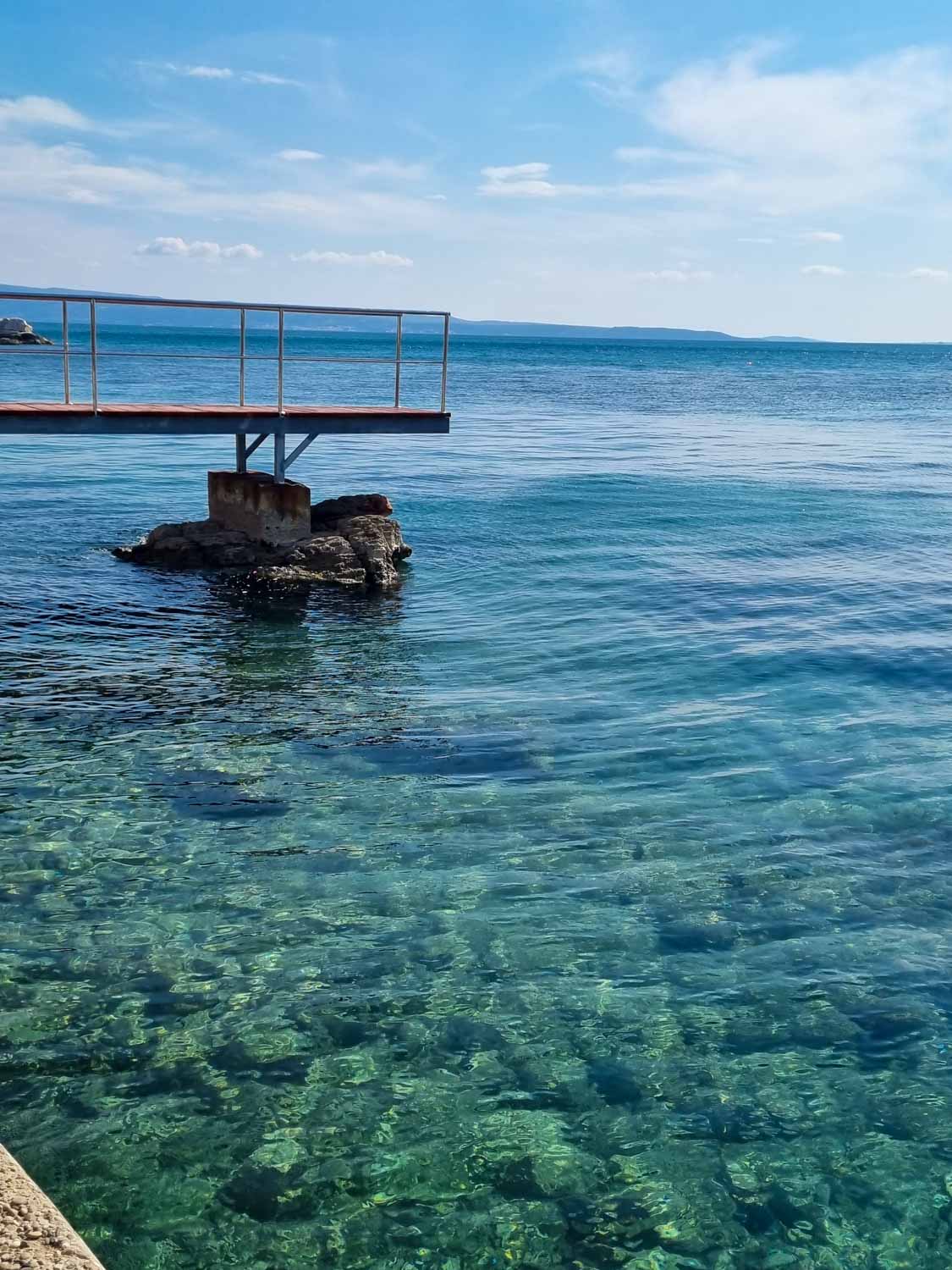

Bacvice Beach is the closest beach to Split, with a sandy stretch backed by a concrete section and a few kiosks. In summer, expect to see umbrellas and loungers pop up as it packs full of sun-worshippers, plus there are a few restaurants at the end.
Follow the path around the coast, and the next cove along is Ovcice Beach (or Little Sheeps beach!). Smaller than Bacvice, it’s really just a curl of pebbly sand along the water, but it’s a prettier spot. There’s a small beach bar here as well.
Continue a bit further and you’ll reach Plaza Firule, another narrow strip of sand backed by a concrete path. Usually a bit quieter than Bacvice, it also has its own cafe bar – and a string of sunbathing cats when we visited!

Watch out for people playing picigin, a traditional Croatian game where you hit a small ball from player to player by hand – officially, the aim is to keep it in the air. In reality, half the fun is hitting it so that the other players have to dive to reach it and end up falling into the water.
If you head in the opposite direction towards Marjan Park, there are more beaches here too including Jezinac, Obojena and Kasjuni beach.
If you’re looking for wide open stretches of sand, like the beaches at Sibenik up the coast, you won’t find anything like that in Split however.
Take a boat trip
With ferries to the nearby islands leaving from the port, as well as day tours, you’ll find plenty of choice of boat trips from Split.

Some of the bigger islands are well worth a full day or longer stay, including Hvar (read on for more details about a day trip from Split to Hvar) as well as Brac, Vis and Korkula.
Check out the Bookaway website for details of ferries from Split and to book tickets
But you can also take boat tours which visit multiple islands, as well as the Blue Cave on Biševo, which is known for its bright blue water, thanks to an opening in the roof which lets the sun shine through.
This full-day boat tour visits the Blue Cave and five islands, including time to swim and snorkel, stopping at the fishing village of Komiza where Mamma Mia was filmed, as well as Stiniva Beach, voted the best beach in Europe.
In July and August, you’ll also visit the Pakleni Islands. Suitable for children aged four and above.

This Blue cave and six islands boat tour is similar, and suitable for kids aged 5+.
Or you can find boat trips to Trogir, which also visit the Blue Lagoon, with time to explore the town as well as swimming, snorkelling and sunbathing along the way.
For a boat tour from Split with a difference, this 45-minute semi-submersible experience takes you around Split harbour, so you can enjoy the views back to the city from above the waves as well as taking a peek at what lies below. This doesn’t run year-round, so it’s worth doublechecking before you book.
Explore with an open top bus tour
Like most major cities, there is an open-top bus tour of Split – but with something of a difference here, given that the old town is pedestrianised.
Instead, there are a couple of different tour options depending whether you want to explore just the city area or venture further afield, handy if you’re visiting Split with kids who don’t want to walk too far.
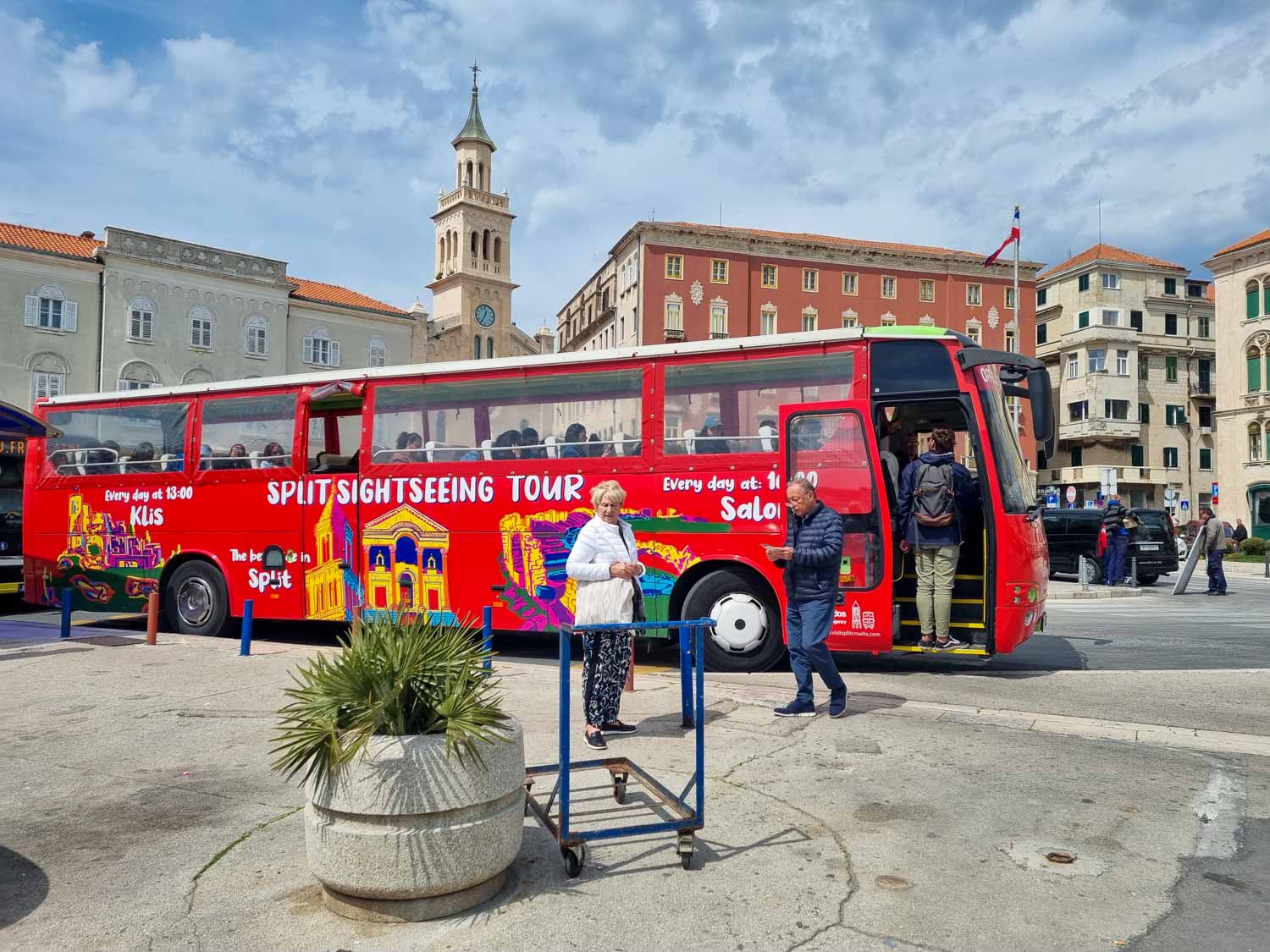
The main ticket for the Split open top bus includes a walking tour of Diocletian’s Palace. First, there’s a tour around the city with an audio guide sharing information about local history, culture and the sights you’re passing, including the marina, the Marjan peninsula, beach and some of the museums.
Then you can join the walking tour included in the price, with three different time options, so it’s easy to fit into the rest of your itinerary.
The company also includes combined 48-hour tickets – Hidden Gems of Dalmatia – where you can enjoy all three routes, visiting Klis Fortess and the ancient Roman town of Salona. You can also get individual tickets for either of those tours, if you’ve explored Diocletian’s Palace and Marjan Park independently.
Take a walking tour
The best way to see Split is on foot, whether you choose a guided walking tour or not – but as well as some of the key sites mentioned above, you can also choose themed tours of the city as well as sightseeing options.
For a tour designed for families, including teens, this two-hour private guided walking tour of Diocletian’s Palace for families includes chocolate and riddles as well as history.

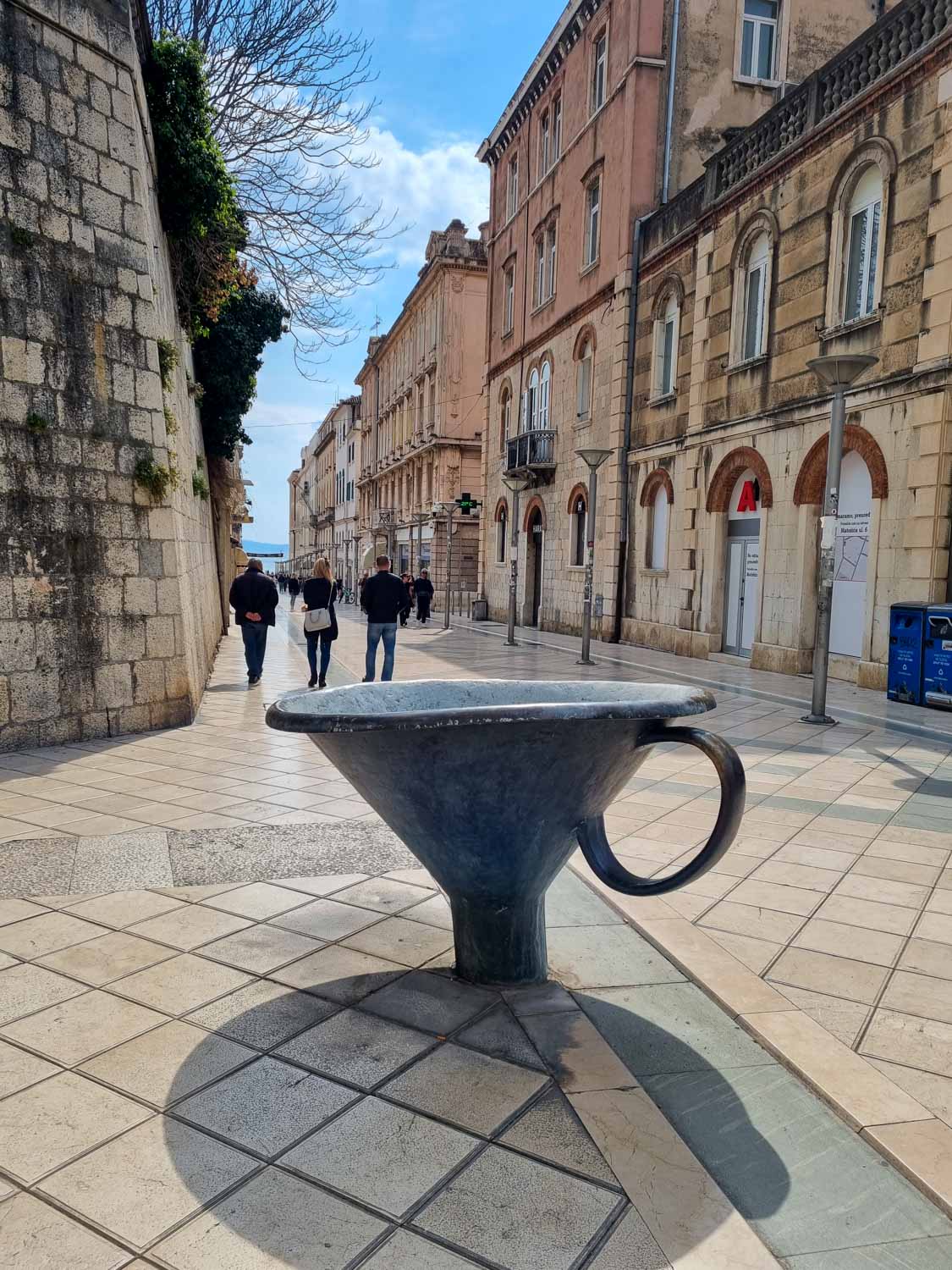
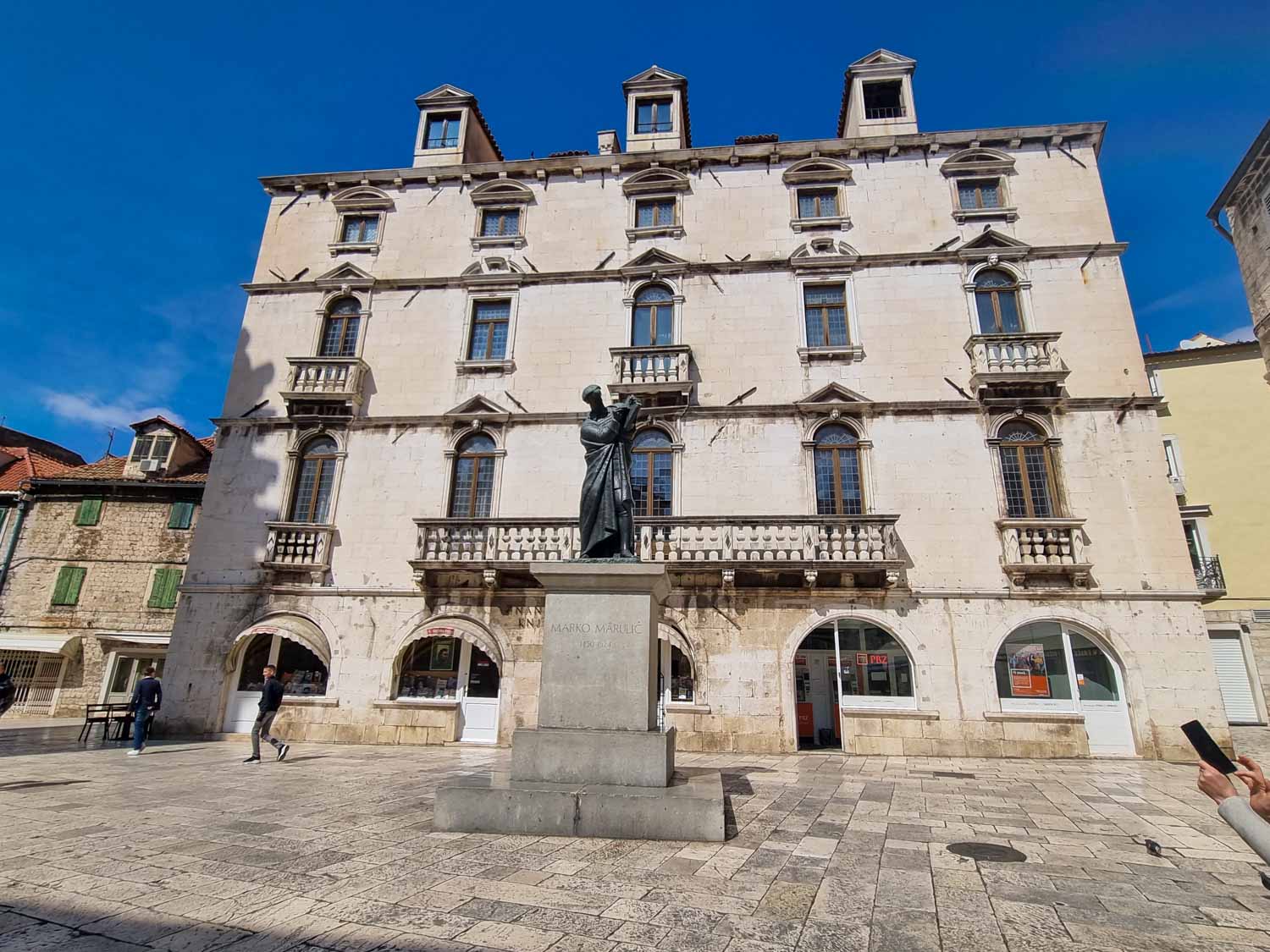
If you prefer a self-guided tour of Split, the audio on this smartphone tour is a good way to visit the highlights. Or this 90-minute small group tour is a good start to get your bearings and find out a few essentials if you’ve got kids with a short attention span (or are only spending a day in Split with kids).
There are also walking tour maps to pick up from the tourist information office and from tourist attractions
There are some food tours of Split, which take you through the ancient streets while also introducing you to some of the city’s best food – this 90-minute tour includes the green market, the fish market and Split’s oldest bakery. They can cater for different dietary requirements if you contact them in advance.

If you want a bigger focus on history, this two-hour Roman History and market tour looks at Illyrian and Dalmatian culture, as well as some of the secrets of Diocletian’s Palace.
And there’s more than just Roman history in Split, home to one of Europe’s oldest Jewish communities, with a Jewish heritage tour which also visits the Roman heart of the Old Town.
Or discover more recent history on a Communism Landmarks Tour and what life was like in the former Yugoslavia. While all ages can join the tour, it’s best for teens and older children interested in that period of history though.
Visit Froggyland
Easily one of the most unusual things to do in Split with kids, a visit to Froggyland is a bit of a marmite experience – with 507 stuffed frogs posed in various tableaux, you’re likely to be weirdly fascinated or run as far as possible in the opposite direction.
The attraction itself is quite small, so you’ll only need a short visit – we weren’t rushing and spent around half an hour, so at more than 10 Euros per person it’s also not a cheap option given how long it takes to wander around. There is a slightly reduced rate if you pay in cash rather than by card though.
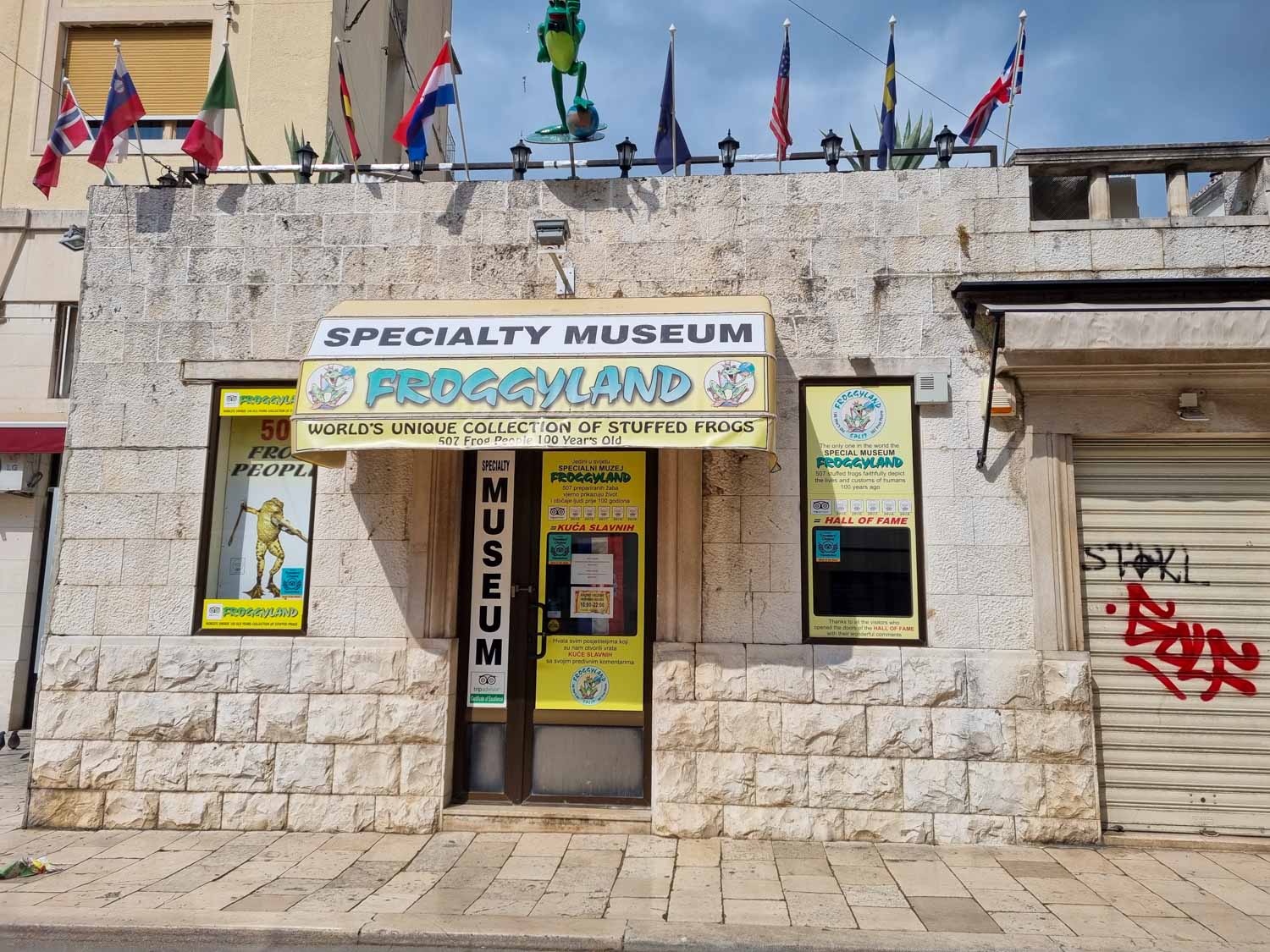

If you fall into the ‘oddly fascinated’ camp, the scenes are remarkably detailed showing scenes of daily and traditional life in Croatia, from a schoolroom to a courtroom, fishing by the river to sporting competitions, a circus and a whole lot more.
There’s plenty to spot in each scene as well, with funny moments and unexpected situations, plus a lot of care and attention has evidently gone into posing all the frogs. Love it or loathe it, it’s unquestionably unique.
No photos allowed inside but if you’re looking for quirky sights or ideas for a rainy day in Split with kids, it’s one for the list!
Split Museum of Illusions
Whether you’re looking for a break from history or something fun to do with kids in Split in the rain, the Split Museum of Illusions is a quirky alternative.
All the displays and exhibits are designed to trick your mind, whether it’s getting lost in a mirror maze, seeing water flowing uphill, or changing your perception of what your family looks like, shrinking, stretching and even decapitating them.
As well as the optical illusions, there’s an explanation of the science behind it, so you can discover more about how the brain works – and why it can be tricked.
There are captions in English as well as Croatian and kids under five don’t need a ticket.
Split Ethnographic museum
It’s not just the museum exhibits which put the Split Ethnographic museum on your list – you can head up to the roof of what was once the grand vestibule of Diocletian’s Palace, for some great views of the Peristil and Old Town too.
The museum is set inside one of the old palace buildings, and is a good place to learn more about everyday life in Split, including a furnished room from the 19th century and historical costumes from villages nearby.
You can also discover everything from lace and jewellery to weapons on display. It’s not a big collection, so you can explore easily in a quick visit and only costs a few Euros for kids – don’t expect anything particularly interactive though.
Entry is currently free with the Split City Card, which itself is free to get – just register in advance and collect when you arrive

Split Archaeological museum
The Split Archaeological Museum is actually Croatia’s oldest museum in Croatia, established in 1820, and it’s here that you’ll find artefacts from the Roman city of Salona (read on for more about visiting Salona) and the Greek city of Issa on Vis.
But the museum traces Split’s history from prehistoric times through to the medieval era, as well as the Greek and Roman periods, ancient Egyptian sphinxes, and even items from shipwrecks nearby.
There’s also sculpture and other stone finds set out in the gardens. Despite covering thousands of years, the museum is still only relatively small and there is limited information in English though.
If you’re planning to visit Salona, you can get combined tickets to the museum and the archaeological site (where few artefacts remains)
Split City Museum
The Split City Museum is tucked away inside a 15th century palace, so the building alone is worth seeing – but it also houses displays on Diocletian’s Palace and Split’s development over the centuries.
Once the home of nobleman Juraj Dalmatinca, the museum in the Papalic Palace also includes medieval sculpture, weapons, coins and documents, along with artwork. Information has previously been in Croatian only, so it’s unlikely to appeal to toddlers and younger kids though.
The City Museum is currently closed for renovations
Game of Thrones museum
While you’re unlikely to be visiting Split’s Game of Thrones museum with younger kids, it’s worth keeping on the list if you have teen fans of the show.
Several scenes were filmed in and around Split, including at nearby Klis Fortress which doubled as Mereen, while other locations in Croatia were also used in the TV series.
The small museum contains five rooms devoted to different locations, with photos and costumes on display, including some authentic props.
After walking past a huge dragon head, a guide takes you through Mereen, Kings Landing, the North, the land beyond the wall and also a room dedicated to the three-eyed raven. At the end, there’s a replica of the famous Iron Throne to take photos on as well.
Buy tickets with free cancellation here.
There’s also a Game of Thrones tour of Split led by a guide who’s a fan of the show, which visits some of the key filming locations in the city
Day trips from Split with kids
There’s plenty to keep you in the city during a family holiday in Split – it is the second largest city in Croatia after all. But Split also makes a great base for some day trips, including to the nearby islands.
Krka National Park
One unmissable day trip from Split with kids is to the beautiful Krka National Park, only around an hour from Split.
You can easily visit independently if you have your own transport but as we didn’t hire a car this trip (having one is not helpful in the city itself!), we joined a day tour to take us there – you’ll find a string of tours to Krka National Park from Split.
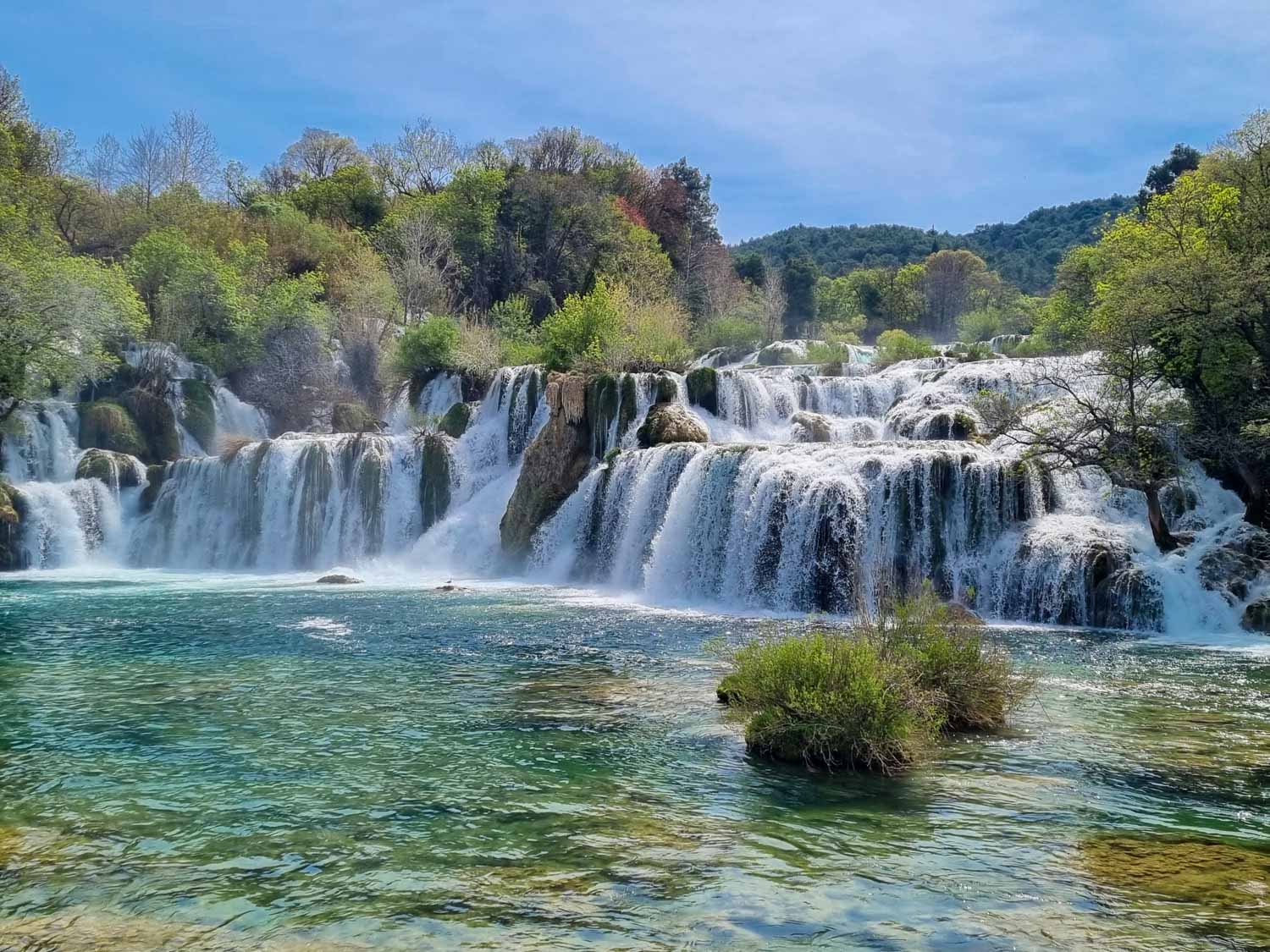
The park is famous for its waterfalls, and you won’t be disappointed: it’s ridiculously pretty strolling along the boardwalk under the trees, with falls and cascades all around, turning the turquoise water into white foam.
You can also see the old blacksmith’s, the mill, laundry and fulling mill, as well as keeping an eye out for the wildlife which makes its home in the national park.
We spotted a small army of frogs, as well as fish and birds galore – no sign of the (harmless) water snakes sadly, but we did see evidence of where wild boar had gouged up the banks. The boar themselves, along with most of the other animals living here, tend to hide away from humans though in quieter parts of the park.
Check out what we thought of a day at Krka National Park with kids



In summer, the tour heads on to the beach at Primošten but if like us, you visit out of peak season, you’ll take 20-minute boat trip along the river to Skradin, a pretty little town in the shadow of a ruined fort. You can spot Venetian and Austro-Hungarian influences in the colourful houses, remnants of two of the empires which once ruled Croatia, as well as walking up to the fortress to soak in the views.
Keep an eye out for the Fortress of Klis as well as the remains of part of the Roman aqueduct on the way. We weren’t the only family on the tour, and it’s a really easy way to explore with kids.
While the Plitvice Lakes are also well worth visiting, and perhaps Croatia’s best-known national park, it’s not such an easy day trip from Split with kids – there are some full day tours from Split to Plitvice Lakes but expect to spend around five hours or more on the journey there and back
Visit Hvar
One of the easiest day trips from Split (as well as to Krka National park) is hopping on a ferry to one of the nearby islands – with a couple of fast ferries each day to Hvar, that’s one of the most straightforward to explore.
In summer, Hvar is all about the beach bars and nightlife, and has a reputation as a celebrity hotspot, but outside peak season, it’s quieter and perfect for exploring.

Start by walking from the port at Hvar Town up the fortress, with its fantastic views back down onto the rooftops and the sea. Inside the old fort, there are archaeological finds unearthed from wrecks and you can look at the old prison, as well as exploring the fortress buildings.
There are several other sites to visit in Hvar Town itself, such as St Stephen’s cathedral on the main square, but it’s a lovely place to simply wander the alleys and backstreets, past little shops and restaurants on the backstreets.
For more tips on how to spend one day on Hvar with kids, check out what we got up to





Keep an eye out for the little wind-up music stands – like a string of mini music boxes – which was a big hit with my daughter and other kids visiting Hvar.
There are beaches within walking distance of Hvar Town too, small and pebbly, they have beach clubs in the summer and you can find sea pools as well as taking a dip in the turquoise waves. Stop for an ice cream at Aroma first, which has some fantastic flavours.
Some ferries will take you to Stari Grad, the old town on the other side of the island, or you can make the half-hour bus trip between the two (or get a taxi if you prefer). Usually quieter than Hvar Town, especially in high season, it’s another enticing spot to stroll.
You can also find ferries to nearby Brac from Split, which takes less than an hour to reach, as well as Vis and Korkula which are both further away, for some more island days out.
Check out the Bookaway website for details of ferries from Split and to book tickets
Klis Fortress
For most people visiting Klis Fortress, less than 10 miles outside Split, it’s because of the Game of Thrones links – the fortress stood in for the city of Mereen in the TV series.
But even if your kids have never heard of Game of Thrones, a visit to Klis Fortress from Split makes a fun day out.

Perched on a cliff top, you’ll find some dramatic views out over the countryside and down to the sea, as well as letting your imagination run wild as you explore the towers and battlements, and venture into some of the tunnels and passages of the fortress.
There’s also a tiny museum with weapons and armour, including cannonballs, as well as a room with photos from the filming of Game of Thrones.
Route 22 buses travel from Split to Klis, as well as open-top bus tours to Klis Fortess if you don’t have your own transport (if you are driving, it’s worth arriving early to find a parking space) and even sunset tour visits.
There are also day tours to Krka National Park and Klis Fortress – while it’s not the cheapest way to see the two sites, it’s a good option if you’re short of time and don’t want to miss either one
Salona
Before Diocletian decided to build his grand palace on the site which would go on to become Split, Salona was the area’s most important Roman town and capital of the province of Dalmatia.
And while today there are only ruins to see, it makes an easy day trip from Split with kids, and a great way to discover some more history of the area.
While most of the artefacts are in Split’s archaeological museum, there is a small exhibition on the site as well, but the biggest reason to visit Salona is to see the remains of the Roman sites themselves.

The amphitheatre dates back to the 2nd century CE, and while it’s smaller than the amphitheatre in Pula (further north in Croatia’s Istria region), there was space for up to 18,000 people – around a third of Salona’s population.
The Manastirine Necropolis is another of the key sites to visit in the archaeological park, where St Domnius (whose body was later moved to the site of Diocletian’s mausoleum, now the cathedral) was buried.
There are also the remains of public baths, mosaic floors and old walls, although only around a third of Salona has been excavated so far
The open-top bus tour also includes tickets for the Roman town of Salona or you can easily get a taxi, while Route 1 buses pass near the ruins (look out for the sign saying Salona ruins) and even a local train to Solin, although it’s not the easiest walk from the station.
Trogir
In some ways, the pretty old town of Trogir is like visiting Split in miniature – you don’t have an ancient Roman palace, admittedly but the Unesco-listed site has its own waterfront promenade, picturesque alleyways to wander and an impressive cathedral.

There’s also the Kamerlengo Fortress to explore, as well as the Venetian-style Cipiko Palace, although half the pleasure is simply ambling through the old town with Renaissance, Baroque and Romanesque buildings and medieval city walls.
Take a 75-minute walking tour of Trogir to discover the main sights, or a similar 90-minute walking tour of Trogir
It’s only around 10 minutes from Split airport, so it’s easy to combine with a flight home if you’ve got time to kill, but also only around 30 minutes from Split itself, so it’s easy to visit for a day trip with kids – connected to the mainland by bridge, even crossing to the island where Trogir is situated is fun.
It’s also easy to visit Trogir by boat – you can find boat tours from Split to Trogir which also take you out to the Blue Lagoon, with a chance to snorkel and swim after you’ve explored the town.
Dubrovnik
As another of Croatia’s most fascinating cities, it’s tempting to combine a visit while you’re in Split. But if you’re hoping to fit in a day trip from Split to Dubrovnik, unfortunately that’s not an easy option.

For those with their own car, it’s at least three hours each way, so a day trip is doable but means a long day with limited time to explore (and a car is more of a hindrance in Split and Dubrovnik themselves).
If you would rather not drive, you can also get private transfers from Split to Dubrovnik
There are buses connecting the two cities, but these take around five hours each way, and unfortunately no trains from Split to Dubrovnik, as there’s no station in Dubrovnik at all.
While ferries to Dubrovnik run during the summer months, it’s at least 4h 25 each way, so while the Krilo fast ferry would give you around four hours in Dubrovnik, you’d spend nine hours getting there and back – and realistically you’d barely get chance to see anything.
Far better to plan a separate stay in Dubrovnik to really appreciate the walled city, rather than a whistle-stop few hours but if you’re determined to at least get a taste of the city, this full-day tour of Dubrovnik from Split includes a walking tour and some free time to explore.
*last updated 2025*
Disclosure: This post contains affiliate links – any purchases you make are unaffected but I may receive a small commission
Fruit/Blue Cave/Vis/Klis Fortress/Salona/Trogir/Dubrovnik courtesy of Depositphotos, all other images copyright MummyTravels


